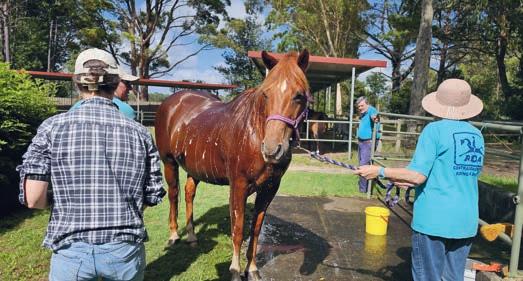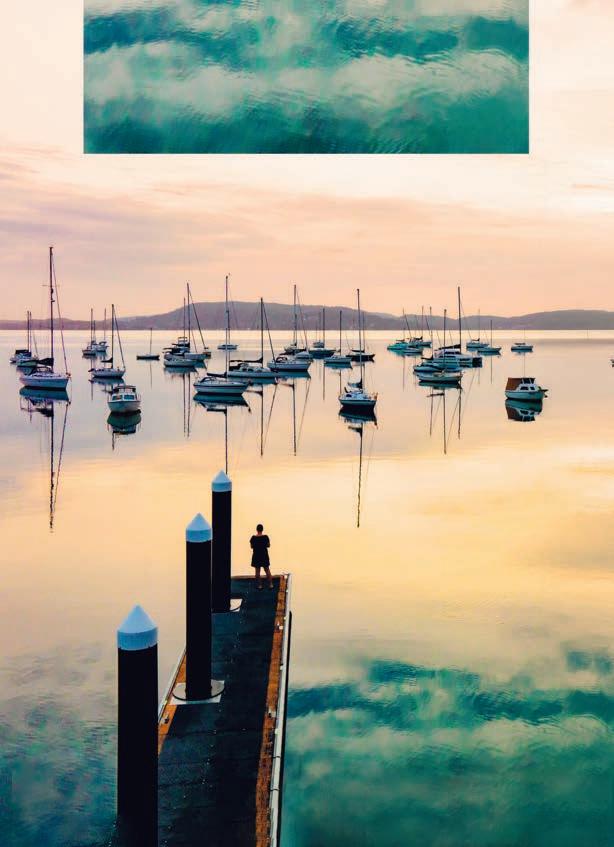
WHERE TO PICK-YOUR-OWN & FARM GATE PRODUCE / WHAT’S ON THIS SPRING
CAFÉS TO BEAT THE MONDAY BLUES / PLANT WILDFLOWERS TO WELCOME BIRDS
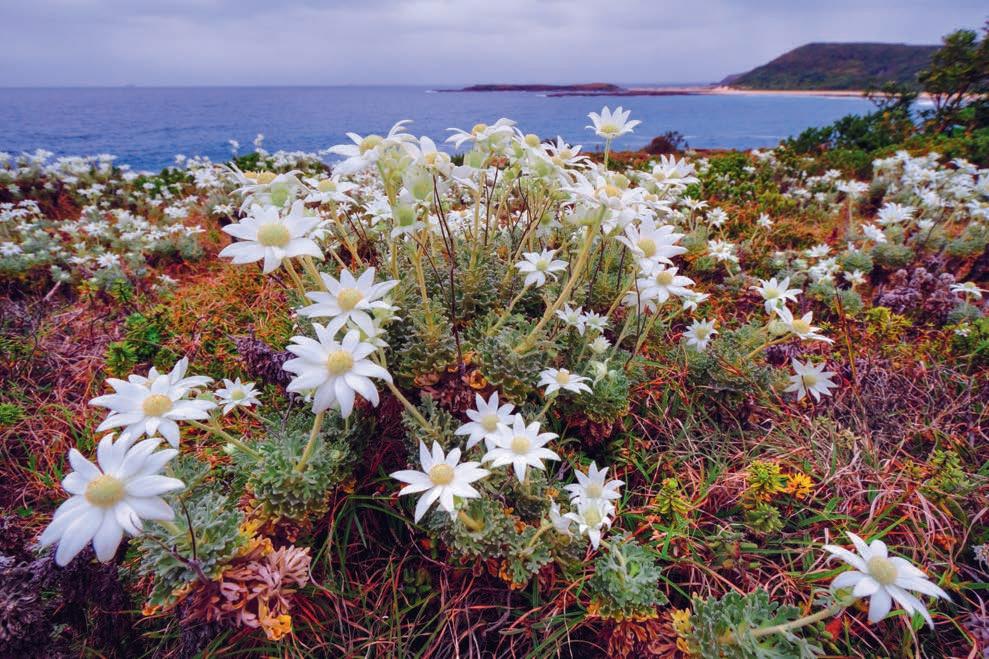
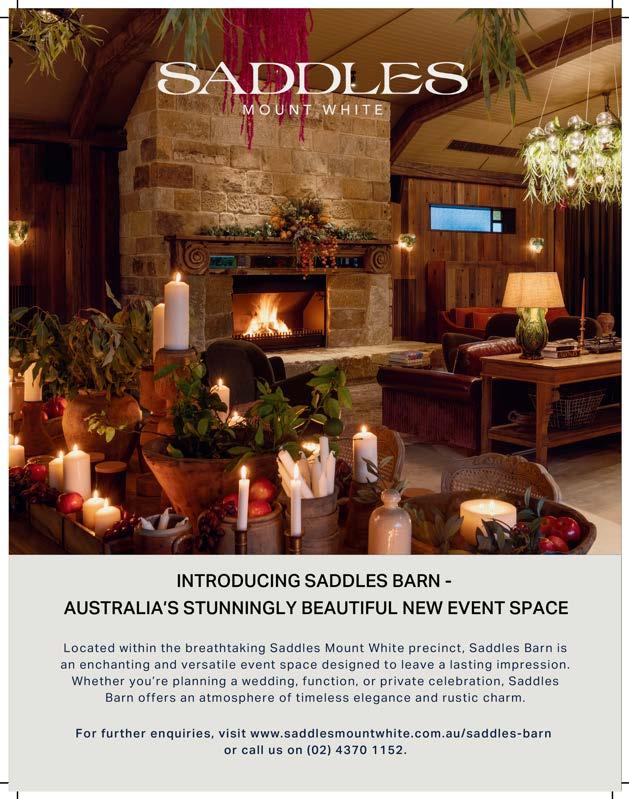


WHERE TO PICK-YOUR-OWN & FARM GATE PRODUCE / WHAT’S ON THIS SPRING
CAFÉS TO BEAT THE MONDAY BLUES / PLANT WILDFLOWERS TO WELCOME BIRDS


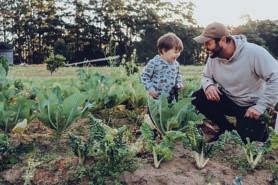
WELCOME 6
DISCOVER THE COAST & LAKES
Map 8
The islands of our waterways: the Central Coast and Lake Mac 9
FEATURE
The dream of waterfront living… 18
LOVING LOCAL
Your spring guide to pick-your-own and farm gate produce 20
PEOPLE OF THE COAST
Once upon a coastal hatters 26
EAT & DRINK
From Yellowtail to Amarilla in Terrigal Haven 28
Happy Mondays: cafés to beat the Monday blues 30
FEATURE
Norah Head Lighthouse keepers had to be ‘male, married and short’ 34
COAST LIVING
The Rise, Pretty Beach 40
Design Matters: good design is about how it makes us feel 46
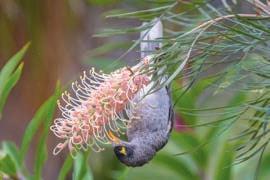
Wild at heart: plant wildflowers to welcome birds … 48
PEOPLE OF THE COAST
Wombat woman: Roz Holme OAM 52
DESTINATIONS
The never-to-be-forgotten experience of India’s festivals 54
The Lake Mac experience 57
WELL BEING
Oxygen therapy: a fresh look at how nature repairs your body 61
The flying dental surgeon with smiles on his horizon 62
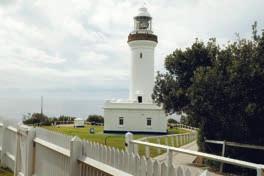
COAST VIBES
The newly reimagined Newcastle Art Gallery grows up 66
The Archibald Prize Exhibition comes to Gosford 68
Move over Sundance, Cannes, Venice and Tribeca, the Central Coast Film Festival is on this November 70
Connecting through creativity 72
OUT & ABOUT
What’s on across the Central Coast this spring 74
COAST FAMILIES
Activities for neurodivergent kids 78
COMMUNITIES WITH HEART
Riding for the Disabled, Somersby 82
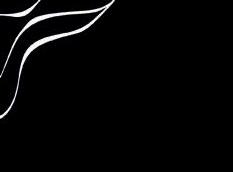

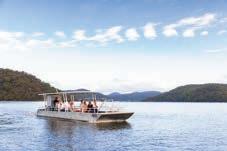




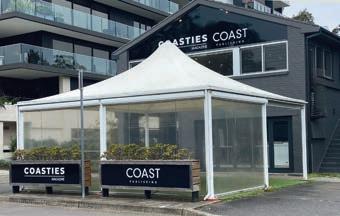
There’s a spring in our step!
There’s something about spring – fresh beginnings, love in the air and the promise of sunny days ahead. So, too, at COAST magazine where we’ve embraced that energy with a few fresh changes of our own though, admittedly, we did get in a little early. We now have a sister magazine after joining forces with the lovely people at Coasties mag. We’ve all moved in together (yes, it’s official – one big happy family!) into a new office opposite the Gosford waterfront. We’re feeling super spoiled working in such a fresh and airy environment, not to mention the great views!
As our hinterland bursts into fresh growth throughout our forests and farmlands, we bring you a guide to the best farms for DIY flower picking (great for selfies in the sunflower fields), where to buy the freshest veggies right from the farm gate, and much more.
Staying on theme, our garden feature this season is all about growing wildflowers and it’s brought to you by our new gardening writer, Linda Ross. So many of you will
already know her as the gardening guru of broadcast and print. We’re thrilled to have her as a local writer on the COAST team!
There’s also the first of some long-awaited restaurant openings with chef Scott Price’s new Amarilla perched over the water at Terrigal Haven. And if you’re like us, wanting to go for coffee or dinner on a Monday but despair of anything being open; well, we’ve found cafés across the Coast that will truly satisfy your Monday-munchies.
And don’t miss what’s blossoming on the art scene in COAST too. The grand, new, re-imagined Newcastle Art Gallery opens. The Central Coast Film Festival rolls out the red carpet (move over Sundance!). And our own Gosford Regional Gallery continues to celebrate its 25th year by exhibiting the finalists in the 2025 Archibald Prize Exhibition.
Here's to fresh air, fresh ideas and all the good things this season brings. We hope this issue of COAST magazine adds a little extra spring in your step!
Catharine
Catharine Retter, Publisher
Congratulations to the winner of two nights at Wilderluxe Lake Keepit, Katie Sercombe.
EDITOR, PUBLISHER
Catharine Retter
editorial@coastpublishing.com.au
SUB EDITOR
Helen Hayes
ART DIRECTOR
Jude Rowe, Agave Creative Group
PRINCIPAL PHOTOGRAPHERS
Lisa Haymes • Merrillie Redden
PRINCIPAL WRITERS
Jennifer Ennion • Kay Fisher • Liz Ginis • Suzy Jarratt
Joanne Karcz • Michelle Leslie • Catharine Retter
Sheriden Rhodes • Linda Ross • Tara Wells
ILLUSTRATORS
Maps: Guy Holt • Lauren Merrick
ADVERTISING
Anissa Vineburg 0408 692 129 advertising@coastpublishing.com.au
Erica Wildey 0418 111 857 erica@coastpublishing.com.au
ALL THINGS DIGITAL
Liz Ginis admin@coastpublishing.com.au
DISTRIBUTION
Alex Tkachenko admin@coastpublishing.com.au
ADMINISTRATION admin@coastpublishing.com.au
COAST is published by Coast Publishing ABN 83 681 639 967
PO Box 6407 Kincumber NSW 2251
ISSN: 2982-1126 (Online) ISSN: 2982-1118 (Print)
COPYRIGHT AND WARRANTIES
The editorial content, photographic content, design and graphic art (including design of any advertisements by Coast Publishing) are all subject to copyright and must not be reproduced in any form without written permission from Coast Publishing.
While we strive to ensure information contained in this magazine is correct and current at the time of printing, details may be subject to change and we recommend contacting venues or event organisers before planning your visit. The information contained in this magazine has been provided by contributors, interviewees and advertisers and their sources.
No warranty is given by Coast Publishing as to the accuracy of this information nor any liability arising from any reliance upon the information contained herein.
FIND US ON Facebook Instagram @coast_publishing
Receive COAST online, free, in your inbox each month by subscribing at coastmagazine.com.au
We wish to acknowledge the traditional custodians of this land, the Awabakal and Darkinjung peoples and their Elders past and present. We recognise and respect their cultural heritage, beliefs and relationship with the land.
PEFCCertified
Paperfrom sustainablymanaged forestsandcontrolled sources
pefcaustralia.org.au
PEFC/21-31-119
Printed in Australia.
ON THE COVER
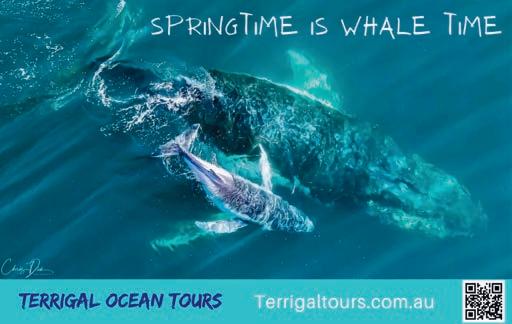



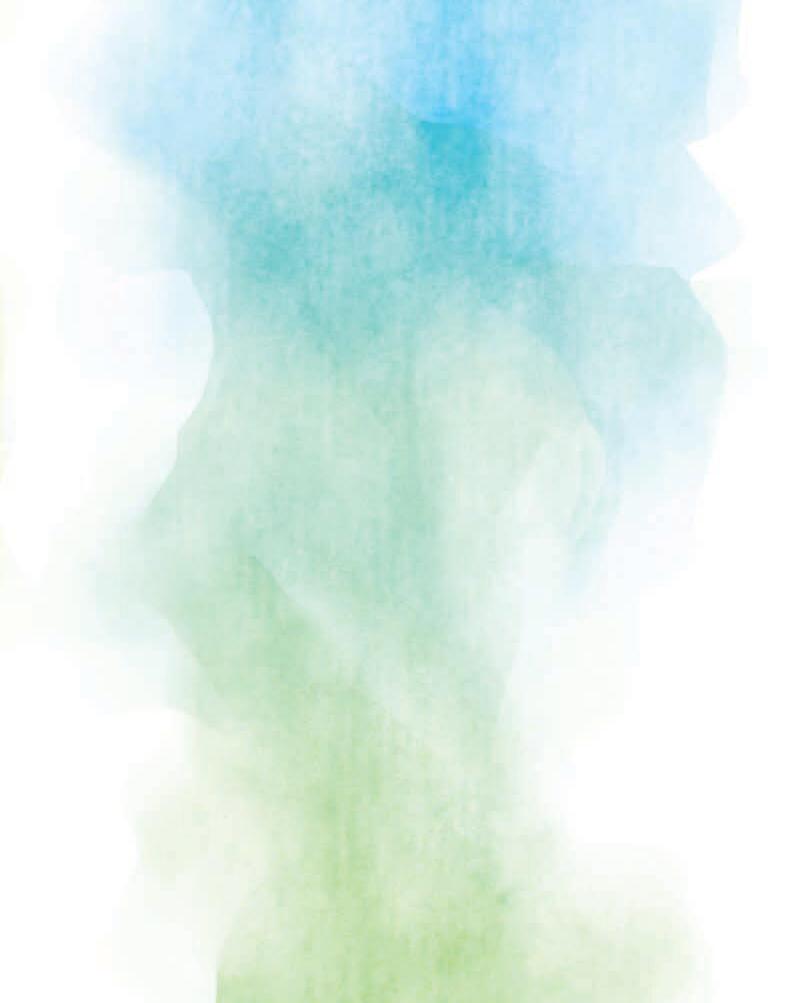
























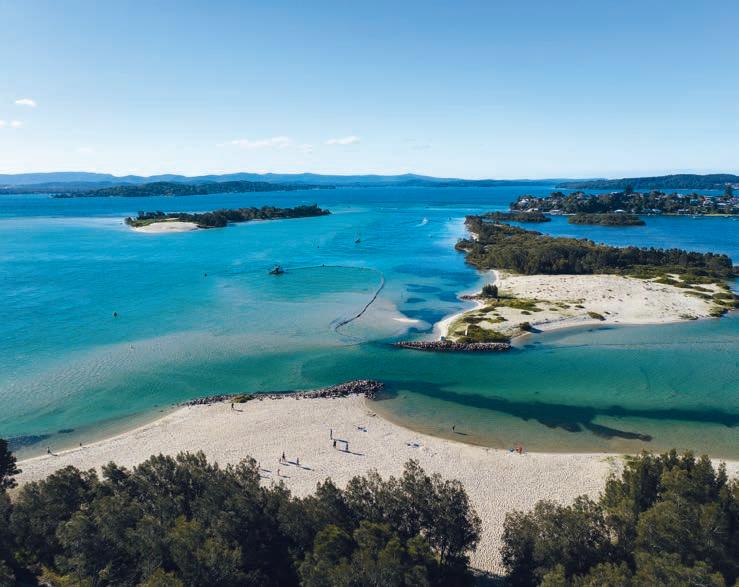
In our last issue we explored the islands of the Hawkesbury River and Broken Bay. This time we look further north into Brisbane Water, Tuggerah Lake and Lake Macquarie. Mostly unpopulated, these islands offer even more variety; from forested bird sanctuaries to view across the water, to picnicking or sunbathing on sand islands. No need to escape to distant lands, they’re right here on our doorstep. There are also several islands, particularly in Brisbane Water, that are not named on popular maps – such as Wilsons Island – that are not accessible to the public
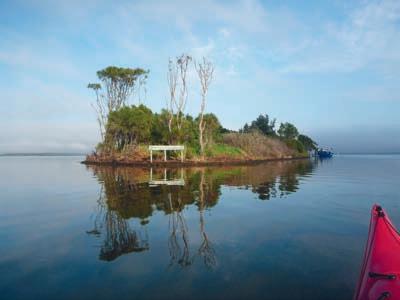
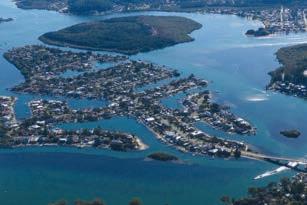
Characteristics: This is one of a group of four islands that lie between the northern and southern sections of Wyrrabalong National Park.
Size: Not stated.
History: Pelican Island was formed in the 1920s, the result of sand dredging in The Entrance Channel.
Why you’d visit: In the 100 years since its creation, a swamp oak forest now covers the higher ground, with saltmarsh mangroves and sedgeland around the island’s perimeter. Pelican Island was declared part of Wyrrabalong National Park in 1991 and is a breeding site for migratory wading birds. Access is limited.
Characteristics: This island off the western tip of the Saratoga Peninsula scrapes in as an island by the skin of its teeth at high tide.
Size: 2 hectares
History: It was formed from spoil created by the dredging of a sandbar during the early part of the 20th century. In the 1960s, sand from the island was also used to fill part of the wetland for the construction of a playing oval. A deep hole at the southern end of the island remains as evidence of the dredger’s work.
Why you’d visit: Swamp oaks (part of an endangered swamp oak floodplain forest) and mangroves have successfully populated the island. The sandbars on the southern side of the island are significant high-tide roosts for wading birds, a habitat that is scarce in Brisbane
Water – so people access is discouraged. The mangroves, too, pose a threat to the waders because the vegetation provides a sneaky approach for foxes, dogs and cats.
Characteristics: One of the three large islands in Brisbane Water, it lies across ‘The Gutter’ from St Huberts Island and was formed by tidal movements carrying sand deposits. It is low-lying with a large expanse of mangrove swamp around its perimeter and dry sclerophyll forest inland.
19 hectares, with the 46-hectare Rileys Island Nature Reserve extending into the inter-tidal zone.
History: Originally known as Shell Island by the early European settlers, it was bought by John Riley in 1855 for £104.17s.6d. The family farmed cattle and grew bananas using seaweed for fertiliser. In the 1860s, at least two ships were built on the island. The Rileys sold to Donald Daisley in the 1940s and, in the 1960s, Hooker-Rex purchased it, planning to build 300 homes and link it by bridge to St Huberts.
Over 500 environmentalists, biologists, anglers, nature lovers and Spike Milligan protested against the threat of ecological damage. The island was saved and gazetted as a nature reserve in 1989.
Why you’d visit: As a nature reserve, it’s best viewed from across the water. Look for 12 different species of microbats, noisy waterbirds and waders including cormorants, egrets, godwits, sandpipers and whitebellied sea eagles.
Characteristics: Originally an island much like its forested neighbour, Rileys Island, it has been developed into a residential, canal estate popular for its waterfront dwellings and boating access.
Size: 0.6 sq km.
History: St Huberts was connected to the mainland by a bridge in the early 1970s at Daleys Point when Hooker-Rex Developments reclaimed the island’s inter-tidal wetlands by raising the land above water level, creating canals to build numerous waterfront properties.
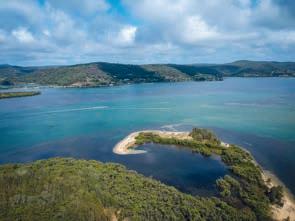

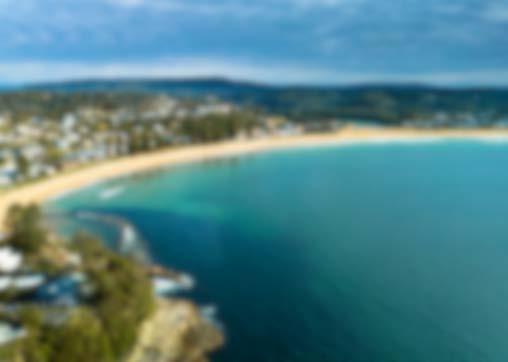

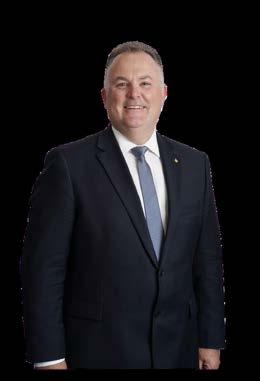
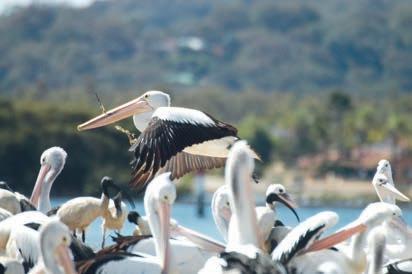
Characteristics: Pelican Island Nature Reserve is actually three islands separated by mangrove channels. You’ll find the islands just across from the Woy Woy ferry terminal and sitting half a metre above sea level. Although named Pelican Island, the local pelicans prefer a more exposed sandbar islet in the area to breed upon, raise their chicks and call home.
Size: 40 hectares.
History: The islands are said to have been formed as the result of the maintenance work in the channel separating them from Woy Woy and by the sediment flow from the construction of the Brisbane Water Drive and railway line causeway.
Why you’d visit: The largest population on the island may well be mosquitoes, but the waters around it are a haven for kayakers to watch pellies, corellas, cormorants, black swans and more.
Characteristics: Lying 1.4 km off Budgewoi Peninsula, the island is known for its birdlife, unusual variety of Sydney golden wattle, coastal tea tree, pigface and open heathlands.
Size: This circular island is not more than 260 m across and rises to a height of 20 m above sea level.
History: It was part of the mainland 6,000 years ago and, before the advent of the lighthouse at Norah Head, the area around it had claimed a number of shipwrecks.
Why you’d visit: The island is a protected nature reserve with up to 7,000 pairs of shearwaters breeding on the island, as do the threatened sooty oystercatchers and around 20 other species of birds. Its rocky cliffs fortunately make access difficult for flightless humans.
Characteristics: Located opposite Terilbah Reserve at North Entrance, it is the largest of four islands in the lake and is the only naturally formed sand island.
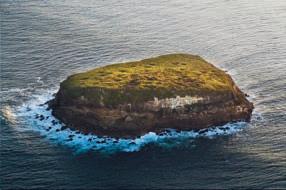
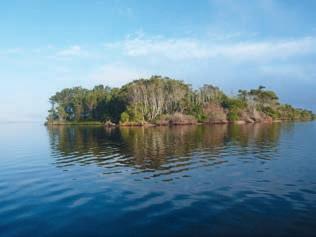
Size: 1.5 km long.
History: In 1991 it was declared part of Wyrrabalong National Park. Why you’d visit: The island is a breeding site for migratory wading birds so access is discouraged. The vegetation is mainly swamp oak, with taller eucalypts and tuckeroos growing inland. The vegetation communities on the islands are all listed as Endangered Ecological Communities, and NSW National Parks & Wildlife has been trying to rid the island of asparagus fern and bitou bush.
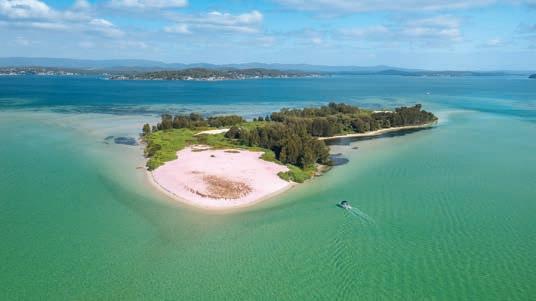
Characteristics: Lake Macquarie is the largest coastal lake in Australia and twice a day, the tides spill through the Swansea Channel washing sand back and forth, creating channels, banks and bars. Most noticeable, are the sand islands: Elizabeth, Pelican and Spectacle.
Why you’d visit: Accessed by boat, this is a beautiful camping and swimming spot (dogs allowed). There are no toilet facilities or garbage bins so BYO portable facilities. The southern end of the island has a large sandhill. You’ll find morning shade on the western side, and afternoon shade on the eastern side of the island. Avoid the northern end whenever the lake is being dredged because of the pipes and machinery obstructions.
Why you’d visit: Accessed by boat, these two tiny islands are part of a popular kayak and paddleboard route across the lake between Spectacle and Pelican Islands to Marks Point. Pack a picnic and find a sheltered, pristine white sandy spot beside the turquoise waters.
Characteristics: Situated at the northern end of the Swansea peninsula across from Spectacle Island and is surrounded by relatively shallow waters. Confusingly, Pirrita Island Nature Reserve is not part of the island but on the opposite mainland at Miners Point.
Size: 9.3 ha.
History: The name means ‘oysters on the mangrove trees’ in the Awabakal language. Europeans originally called the island ‘Coon Island’ after its first resident, Herbert ‘Coon’ Heaney, so named for the coal
dust he bore on his face or, perhaps because the word is offensive, it’s also been said he resembled a racoon and was therefore nicknamed ‘Coon’.
Why you’d visit: You’re much more likely to visit the Pirrita Island Nature Reserve which has a stunning, accessible boardwalk that winds through the lakeside mangroves. There are great views of the lake and neighbouring islands, walking trails and an abundant birdlife. As well as a viewing platform, the reserve has BBQ facilities, picnic tables, shelters and toilets. It’s accessed from Dobinson Drive, Swansea. 8
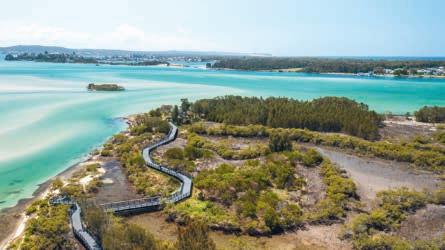

Characteristics: No more than a fairly flat rock off Lake Macquarie, it has a reef that extends from its eastern end and is honeycombed with caves. The island is an important roosting site for sooty oystercatchers, wedge-tailed shearwaters, seagulls and is visited by resting little penguins and seals. The Awabakal name for Moon Island is ‘Nirritiba’, a place of mutton birds.
Size: 1 ha.
History: Its history is intertwined with that of Lake Macquarie, which was called Reid’s Mistake for a quarter of a century, after Captain William Reid who, in 1800, thought Moon Island was Nobby’s Island and that he was at the mouth of the Hunter River. He loaded his ship
with coal from a seam on the southern headland, still thinking he was in the Hunter River. He thereby inadvertently opened up both the local coalfields and the lake.
Why you’d go there: Accessed by a 10-minute boat ride from the Swansea Bridge, it is a popular dive site with arches to swim through, caves and rocky shelves to explore, or just drift down the side of the rock to explore soft and hard coral beds and marine life. Weedy sea dragons live in the kelp beds. Turtles, wobbegongs, bull rays, grey nurse and Port Jackson sharks visit the caves and ledges.
Characteristics: Located in the southern area of the lake, the island is also referred to as ‘Boroyiroong’ or ‘Bulba’, an Indigenous word for island. The Awabakal people consider it a sacred place. It was home to Wau-wai, a monster fish that terrorised the locals.
Size: 1.6 km long and 70 ha over all, making it the largest island in the lake.
History: Europeans introduced rabbits and quail to the island for hunting and in the early 1870s a sawmill was built to process the spotted gum and blackbutt timber. As the timber felling gave way to grasslands, cattle were swum or rowed to the island for grazing, and concrete water tanks were built to supplement the scarce water supply. Intriguing tales surround the local name for the island, ‘Bury-Your-Own’. In 1929, the island was declared a reserve and today it is part of the Lake Macquarie State Conservation Area.
Why you’d go there: There are safe anchorages on the northern side of the island, but there are no facilities on land. Visit for the natural beauty and wildlife. It is a refuge for koalas, wallabies, sugar gliders and a wide range of birds including white-bellied sea eagles.
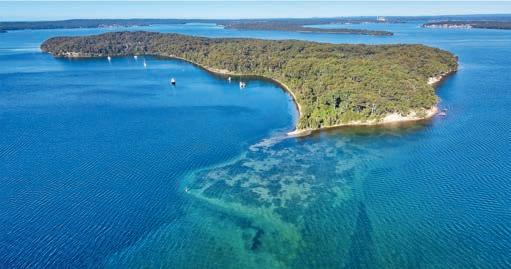
See the previous issue of COAST magazine online for Part I of Islands of our Waterways: the Hawkesbury River and Broken Bay at issuu.com/coastpublishing
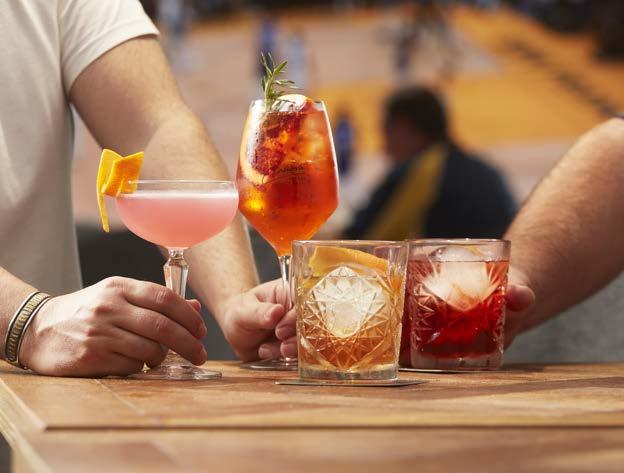
WELCOME TO YOUR HOME GROUND
Experience the heart of East Gosford at the Elanora Hotel, lovingly called ‘The Elly’ by locals. With two giant 5m x 3m HD screens for all major sports, it’s the perfect place to catch the game with friends or family.
Savor award-winning steaks and a menu crafted by international chefs, plus a wide range of drinks to suit any occasion. Come for the game, stay for the food, and make memories at your home away from home. Welcome to The Elly!
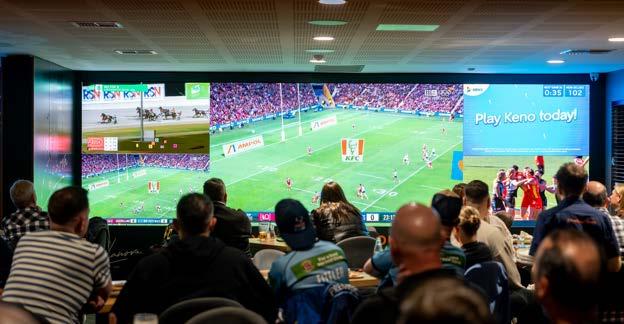
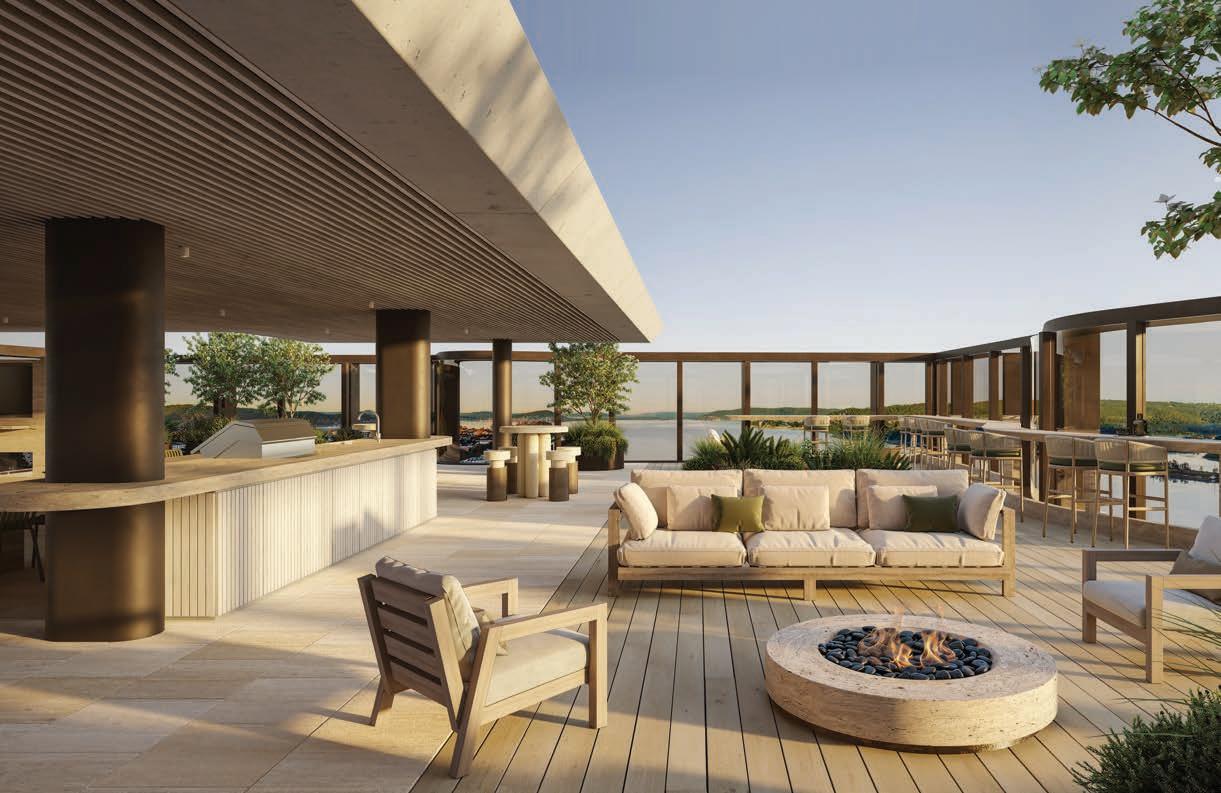
The ultimate front row seat. A collection of completely waterfront homes in the heart of the Central Coast. Exchange on 5% and move in December 2025. Final release of The Waterfront, Central Coast Quarter now selling.
2 bed District Views from $770k | 2 bed Waterfront from $920k 3 bed Residences from $1.99m | 4 bed Sky Home $3.2m


ENQUIRE NOW 1300 146 554
The dream of waterfront living comes alive in Gosford
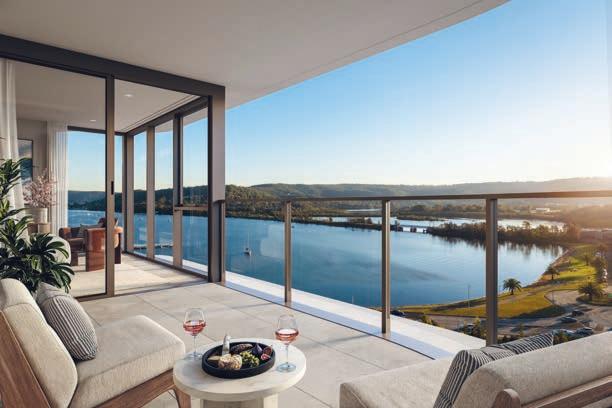
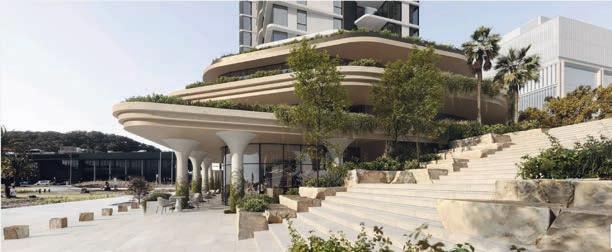

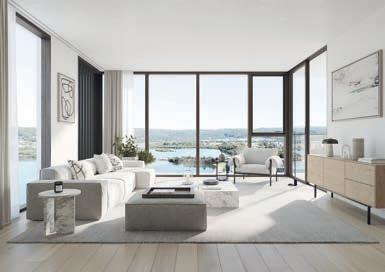
If you were ever thinking of buying an apartment with spectacular water views, you’d want to be assured those views could never be built out.
Located just by Brisbane Water, where the sun ignites a thousand diamond sparkles on the water, you can sit back and watch low flying pelicans glide the air currents as sailboats gently bob at their moorings. Your panorama stretches across the calm waters to the green bushland ridgetops of Brisbane Water National Park to the west, Bouddi National Park to the east, and south to the statuesque Lion Island and Palm Beach headland.
Stage 1 of The Waterfront is due for completion in December this year with over 80 per cent already sold. Limited opportunities for unparalleled luxury remain.
The apartments have been meticulously designed for seamless indoor-outdoor living, or you can also choose to relax and entertain on the Panorama Deck. The decor throughout The Waterfront is
contemporary and coastal, with warm blonde timbers, creamy coastal tones, lush fabrics and a focus on natural light.
The Waterfront is the new face of a vibrant and revitalised Gosford, with the convenience of cafés and retail therapy within its precinct as well as a landscaped streetscape that lets you wander through the gardens to adjoining parklands.
Stage 2 of the Central Coast Quarter will see a striking central pavilion, cascading terraces, outdoor dining, retail and function spaces, and more. A new pedestrian link will connect The Waterfront to parklands, Mann Street and Baker Street.
The developer and builder, Urban Property Group, was the first developer in Australia to offer a 10-year Latent Defect Insurance giving their home-owners long-term peace of mind. It has an enviable reputation for quality constructions and unwavering attention to detail.
To learn more about your dream of waterfront living, visit the website: centralcoastquarter.com.au
Photographs are artist impressions only so the final product and aspects of the project may differ.

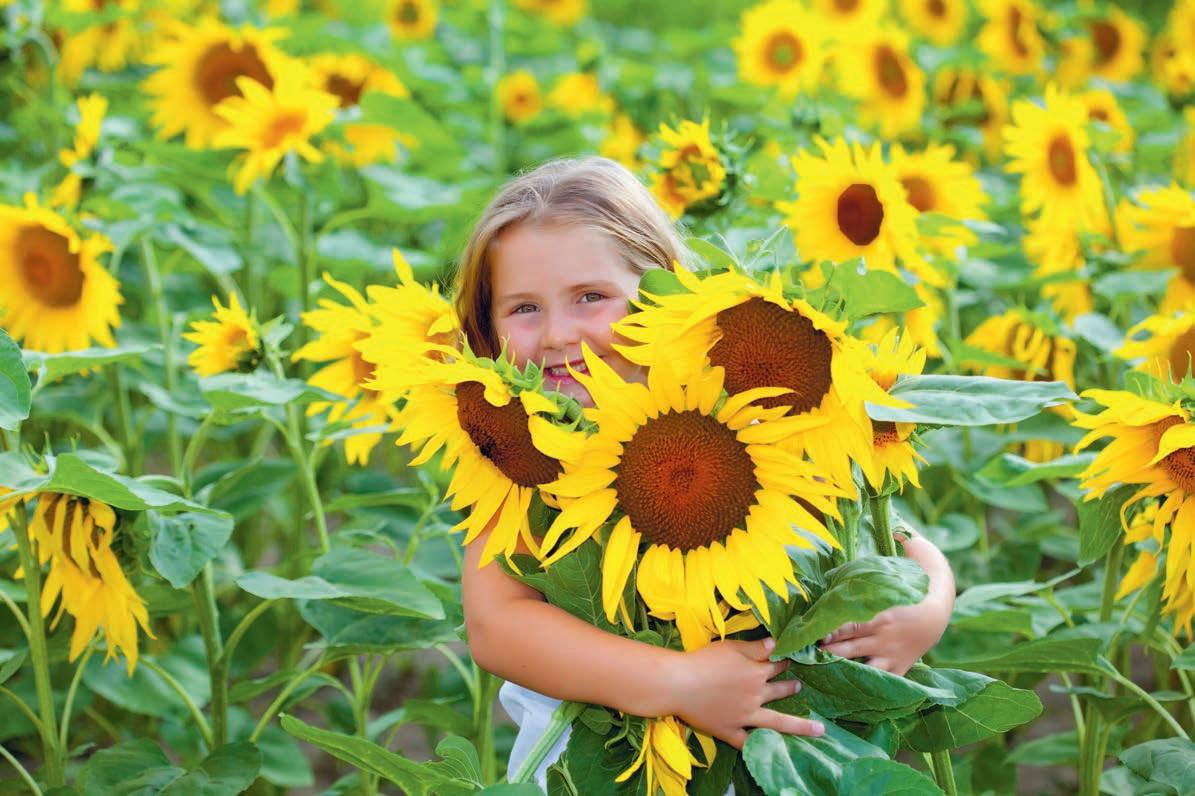

The Central Coast is known for its rich hinterland, abundant with farm fresh food produce. Dotted throughout the region, these farms are bringing locals and visitors from afar, offering poultry, eggs, seasonal fruit, flowers, vegetables and more.
We bring you this farm gate guide, already known to Central Coast chefs-in-the know, for the best in farm fresh. It’s where you can buy produce direct from the farm or even handpick your own flowers, fruit and veggies. Not only do you get to choose your favourites but it’s also a great family day out.

Produce available in the spring picking toSeptemberseason: November
Because the weather can hasten or delay the availability of produce, it’s always safer to check individual Facebook pages for live updates before you leave home.

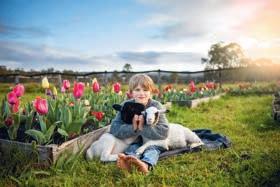


HORSESHOE VALLEY FARM, Dooralong Valley lovecentralcoast.com/horseshoe-valley-farm-apiary
This 32-hectare family-owned farm offers pick-your-own seasonal field-grown flowers including dahlias, zinnias and sunflowers
You can also buy single-source pure raw honey, and chemical-free, grassfed meats. This small farm runs ticketed event days only, so bookings are essential. The children will love lambs to feed during the lambing season. Sorry no pets (for safety) other than the farm’s Maremma sheep-guardian dogs.
Where: 830 Dicksons Rd, Dooralong Bookings: facebook.com/horseshoevalleyfarm

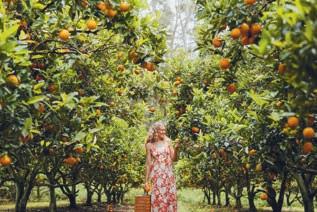
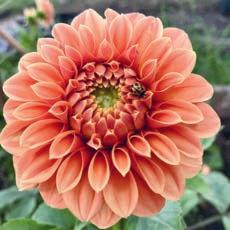
MELIORA FARM, Peats Ridge
lovecentralcoast.com/meliorafarm
During Spring you can pick your own Navel oranges, lemons and Hass avocados on this very family-friendly 100-year-old farm. Open 10 am to 3 pm, bring a picnic basket and blanket and you are welcome to enjoy the fresh air and scenery.
Where: 1504 Peats Ridge Road, Peats Ridge Bookings essential: meliorafarm.com.au

CEDAR FARM, Dooralong
lovecentralcoast.com/cedarfarm
Jack and Kay run this century-old family farm with its 3,000 citrus trees. You can pick your own Navel oranges from September to October, or Valencia oranges in November. No chemical sprays are used on the farm. It’s a great family day out with haycart and pony rides, weather permitting. Dogs on leads are welcome too. The farm is open 10 am to 4 pm, no bookings required.
Where: 48 Dittons Road, Dooralong Check: Facebook for juicy live updates.
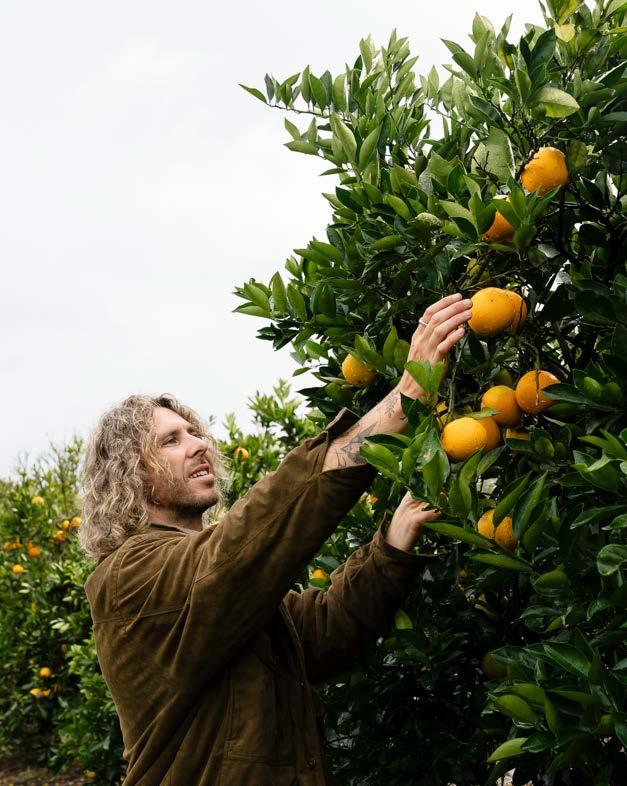
Abundant with farm gate producers growing fresh-as-it-gets seasonal fruit, veggies, flowers and more, the Central Coast hinterland is waiting to be uncovered this spring.
Find your seasonal guide to pick your own experiences
MARGINS MUSHROOMS, Woy Woy lovecentralcoast.com/marginsmushrooms
You can purchase bags of mushrooms – white mushrooms, Swiss browns and oyster mushrooms – from the farm shed, and the farmer will even show you the patch where your mushrooms were picked fresh that day. The farm also offers 15-person tours of their family-run mushroom farm (great for club outings). Learn all about growing mushrooms and receive a large bag of mushies to take home. Open Monday to Saturday.
Where: 536 Woy Woy Road, Woy Woy Bookings: marginsmushrooms.com.au/tours
ALAN FOODS, Jilliby lovecentralcoast.com/alanfoods
This permaculture market garden sells chemical-free fruit and vegetables including herbs, microgreens, zucchini, capsicum, eggplant and snow peas. The farm gate stall is open on Friday afternoons or you can order veggie boxes up to 9 pm Thursdays for pick up Friday to Sunday.
Where: 58 Dickens Road, Jilliby Orders: facebook.com/alanfoods

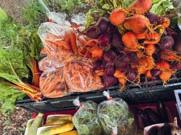
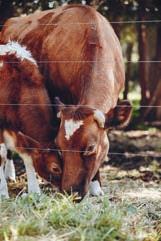
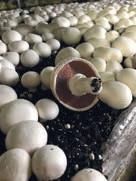
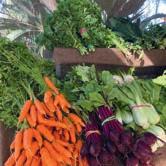
FANELLI ORGANICS, Mangrove Mountain lovecentralcoast.com/fanelliorganics
This regenerative farm in Mangrove Mountains grows certified organic fruit and veg. Pre-order your produce and it will be harvested fresh from the farm’s paddock on the day of collection. Pick up on Sundays from 10 am to 2 pm.
Where: 10 Pembertons Hill Road, Mangrove Mountain Orders: fanelliorganics.com.au/shop
FEET GOURMET, Ourimbah
A small-scale market garden that uses regenerative practices to grow chemical-free veggies including beetroot, kale, spinach, lettuce, broccoli, cauliflower, onions, leeks, garlic and lots more. Purchase from their farm gate open most weekends through the growing season. You can also order their mixed seasonal veg boxes, picked fresh and offering a huge variety of veggies and herbs. Orders close Friday 10 am for pick-up on Saturday.
Where: 197 Ourimbah Creek Road, Ourimbah Orders: little-feet-gourmet.square.site
GRACE SPRINGS FARM, Kulnura
As well as offering farm tours, Grace Spring Farm’s focus is on sustainable, regenerative farming, producing chemical-free, grass-fed dairy beef, pastured eggs, chemical-free veggies, garlic and honey
Pre-order for weekly pick-ups.
Where: 1128 George Downes Drive, Kulnura Orders: grace-springs-farm.square.site
See also: HORSESHOE VALLEY FARM listed previously.

O A S T A L
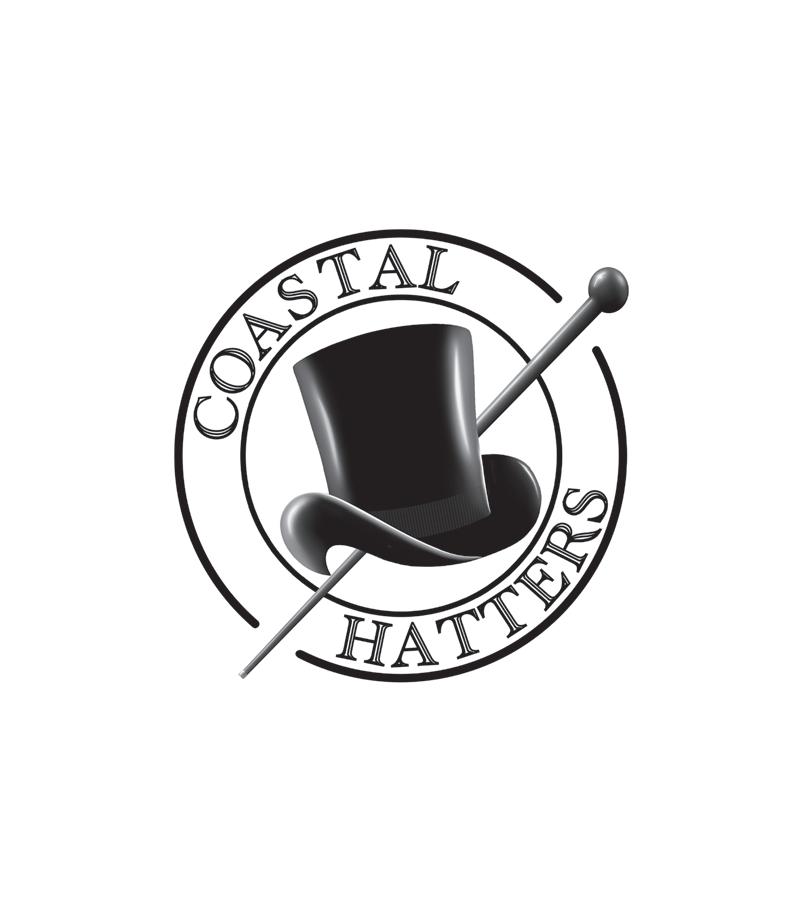
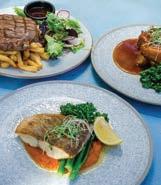

A T T E R S
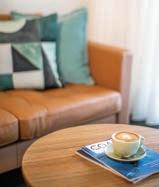

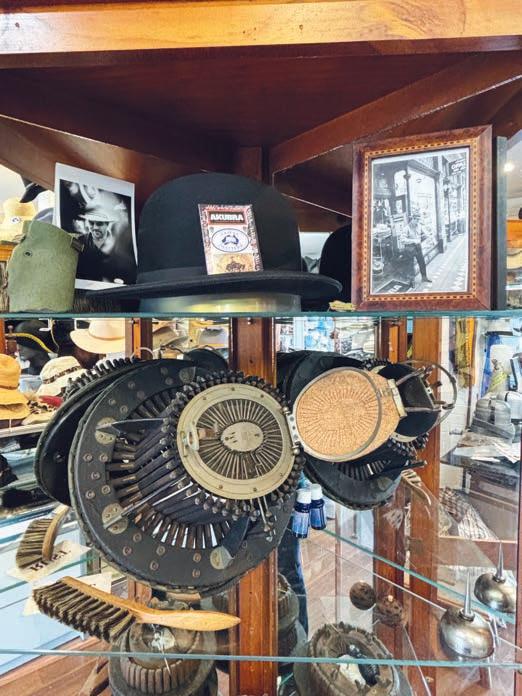
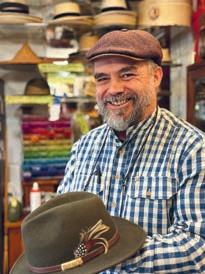
He’s long grown out of it and it’s been years since his daughter has worn it too. But such is the lure of a favourite hat that Eric Wright still has his very first, very small, Akubra. The grey felt hat that Eric’s parents first placed on his one-year-old head is proudly on display along with a photo of his daughter wearing it at the same age. It sits among the 3,500 hats bursting from Coastal Hatters, the specialty hat store he opened at Ettalong Beach in 2024.
Walk through the portal into Coastal Hatters and you walk into a wonderland of hats.
While the shop may be new to Ettalong’s Galleria, it’s not the only feather in Eric’s hat. More than three decades experience as a hatter –most notably as owner of Sydney’s renowned Strand Hatters – means Eric quickly sizes up any customer who walks in the door.
For shoppers more accustomed to choosing from a limited number of styles and sizes, Eric uses his expertise to cut through any feeling of being overwhelmed by the choices his shop offers.
‘After ten minutes of conversation, we’re down to three hats but I needed the 3,500 hats to get there,’ says Eric.
Picking the perfect hat is surprisingly straightforward. First is ‘purpose’ – what is the hat needed for? Then the customer has their say on preference: what colour and style they like. When it comes to fit, or sizing, Eric takes over.
He knows that a tighter-fitting hat doesn’t stay on any better – the right size does – and freely offers a secret weapon for all purchases: extra hat elastic.
‘I have a philosophy,’ says Eric, ‘I’d rather you wear it than chase it.’
There’s always a hat on Eric’s head, perhaps a brown flat cap or a wool-felt fedora from his personal collection of 450 hats. Wander among stacks and stands of new hats to discover a ‘museum’ of not-for-sale pith helmets, an antique bicorne admiral’s hat, his grandfather’s 1911 Yorkshire school cap and more, shelved in display cabinets and stacked to the ceiling in hat boxes. His favourite? ‘Depends who I am today.’
When Eric moved to the Central Coast seven years ago, he was surprised to discover that another big name in the hat world had preceded him. The Rigon family, owners of Rigon Headwear, had already moved their base from Sydney to West Gosford. As a
As specialist hat stores become scarce, so too do people capable of caring for quality hats. It means there is great demand for Eric’s hat restoration service.
result, 85 per cent of stock in Coastal Hatters is either designed or manufactured locally with recognisable brands such as Cancer Council and Canopy Bay by Deborah Hutton in collaboration with Rigon.
As specialist hat stores become scarce, so too do people capable of caring for quality hats. It means there is great demand for Eric’s hat restoration service. The workbench overflows with tools, decorative plumes spill from tiny drawers, and an antique conformateur used for measuring head sizes sits in a cabinet. Eric has cranked up the steam machine and three stretching moulds sit ready on a table. If a new hat is not on the cards, bring in an old one for re-shaping, refreshing or remodelling.
If Ettalong seems an unlikely location for a specialist hattery (that’s the proper word for a specialised hat shop) it’s not. ‘My demographic is people with heads,’ says Eric.
With a firm belief that wearing hats should be fun and enjoyable, Eric guides even the most hesitant of customers through to the best result.
‘People will say, “But I don’t know where to wear it”,’ says Eric, ‘I answer, “On your head”.’

ABOVE RIGHT Hats are displayed throughout the store for all styles and occasions.
OPPOSITE PAGE A display cabinet with a hat conformateur used for making hats to custom-made size and head shape.
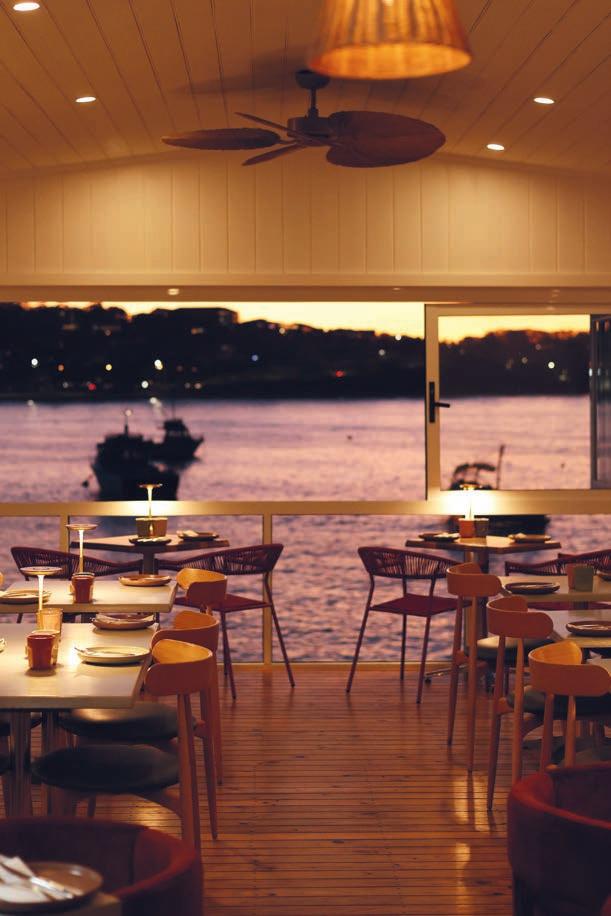
From Yellowtail to Amarilla in Terrigal Haven: where tapas meets the tide
When you’ve built a reputation of excellence for nine years at Yellowtail, a much-loved and hatted restaurant in Terrigal, why would you want to start over? Why change to a new location that needed DA approvals and a heap of money spent on renovations?
‘The view, the location had a lot to do with it,’ admits chef-owner Scott Price. ‘When the opportunity came up to buy the café building at the end of Terrigal Haven – perched right on the water with the best seat in the house across the sea and to the lights of Terrigal –I knew it was an opportunity too good to miss.’
Welcome to Amarilla, where Spanish cuisine meets laid-back coastal charm.
So why Spanish cuisine?
‘Amarilla is Mediterranean-style Spanish,’ says Scott. ‘It just felt right for the seaside setting.’
It’s not until I look up the meaning of Amarilla later that I see what’s Scott’s subtly done with a quiet nod to Yellowtail: Amarilla means ‘yellow, shiny and sparkling’ in Spanish.
He is no stranger to Spain and its cuisine. He’s been a chef for 30 years and, while working in London, spent many of his summers in Spain, especially throughout Catalonia, Barcelona, the Basque country and Madrid – famous for its tapas culture of dishes made for sharing.
‘Tapas lends itself to casual dining,’ says Scott. ‘You can still expect the “wow” factor at Amarilla but in a more approachable fashion. While Yellowtail was a special occasion kind of place, Amarilla is a restaurant you can come to every week. The food still meets our exacting standards but with a friendly price point.’
Scott’s team from Yellowtail took a well-earned break during the renovations and have now joined him at Amarilla. ‘They’re one of the best teams I’ve ever worked with,’ says Scott. ‘So I’m thrilled they’ve chosen to come with me on this next adventure.’
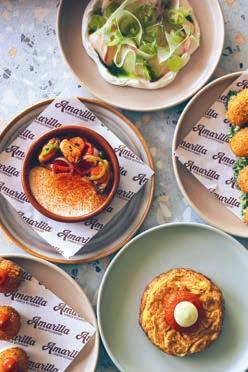
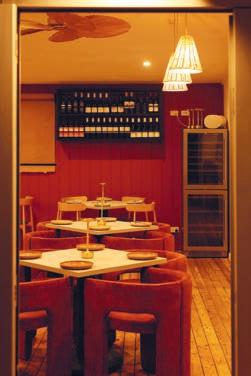
bread before diving into an array of tapas plates designed to reawaken your taste buds. Think whisper-crisp croqueta with a velvety filling of snapper or cheese. Empanaditos, pasties packed with duck and mushroom. A grilled seafood tapas platter bursting with oceanfresh flavour.
Among the larger platos principales there’s the crown jewel of Castilian cuisine, cochinillo. This roasted pork belly is served rolled, with charred peppers, cauliflower purée and the subtle sweetness of Pedro Ximinez pears.
The little ones are looked after too, with favourites such as crumbed chicken tenders, cheese pizza and yummy ham and cheese croquettes.
The menu is designed to be shared, as well as paired with Hunter Valley-grown Iberian varietals – Tempranillo, Verdelho, Touriga and more.
Spanish tapas is a true celebration of flavours subtly mixed with the art of lingering. And while you’re lingering, you’re almost guaranteed to share the view outside with the pelicans awaiting the return of the fishing boats. And at the right time of year, you may also spot a mother whale shepherding her calf into the calm, protective waters of Terrigal Haven.
But when the dishes arrive at your table? Even the view may be forgotten. C
amarilla.com.au
Open Thursday for dinner. Friday to Monday for lunch and dinner. And Sunday for lunch.

Beat the Monday cafe blues with this selection of eateries still serving up the goods when others take a break.
On the Central Coast we practically have coffee on tap. So many local cafés are ready and willing to meet our caffeine obsession with a social buzz and good times. But come Monday, many of those establishments need their own R&R and our love of a cuppa is briefly unrequited. Thank goodness, then, for these coffee shops and restaurants that never rest.
For those mad about their daily macchiato or flat white, follow the freshly roasted scent towards a café owned by a self-described ‘bunch of crazy, caffeinated, coffee heads’. Glee Coffee at Wyong was founded by two brothers and their wives who share a passion for a good brew. The café alongside their roasting warehouse (affectionately dubbed ‘The Source’) has maintained a tight focus for more than 10 years. Expect single origin coffees with a side of toasties and a selection of baked goods.
gleecoffee.com.au
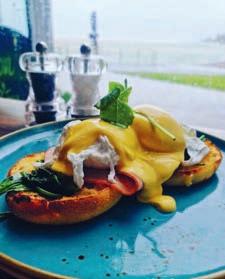

Ticking over more than a decade gracing The Entrance’s prime position, Waters Edge Restaurant kicks off with leisurely breakfasts from 8 am. Come lunchtime, their expertise in seafood comes to the fore. Whether sitting on the waterside deck or checking out the view from floor-toceiling windows, patrons keep requesting the seafood platters and baked fresh whole fish. Notch it up with share-style lunches or keep it simple with coffee served all day.
In spring, Komuniti’s oasis-like rear garden courtyard becomes a salve against life’s busy-ness. Using local and organic ingredients wherever possible, choose from favourites like wagyu beef or chicken schnitzel burgers. Or do your insides a favour with a brown rice bowl served with corn fritters and veggies with a miso dressing. Mix up your drinks with a sticky chai, Legend coffee roasted in Gosford, or a ‘Cacao Ceremony’ superfood mushroom blend. A ‘Cookies and Cream’ smoothie tastes decadent but is actually the goodness of banana and vanilla whey powder paired with the choccy burst of cacao. Yum without the food coma glum.
komuniti.au
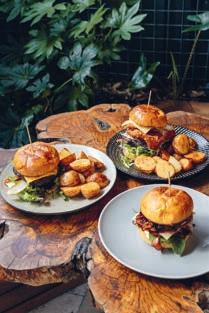
watersedgeseafood.com.au
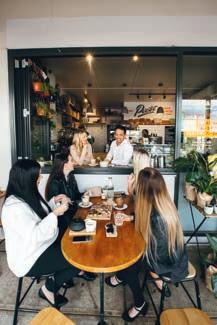
Once upon a time, it was simply Toowoon Bay’s pie shop. The Picot family, owners since 1988, upped the ante to offer more goodies to become Flour & Co. The pies are still there, of course, and so are flaky croissants, huge bliss balls and matcha lattes. Everything’s made fresh in-house daily, making it tempting to grab a loaf of sprouted wheat sourdough to take home after your coffee fix (steaming hot or iced) is met.
Facebook @flourandcobakery Instagram @flourandco_
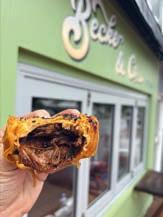
What does it take for a café located in a beachside suburb – but not near the actual beach – to survive and thrive? Consistently good food, reliably excellent coffee and friendly staff. Take a perch outside with a pooch at your feet, or choose a sage-coloured booth inside to savour chilli scrambled eggs with goats’ cheese or a sticky glazed pork belly salad. cafemocha.com.au
There’s a bit of a theme across these hardworking Monday-openers: take a long-lived and long-loved cafe, pop in new owners armed with renewed gusto, and make everything fresh and local. That’s the case here too with The Fat Goose, although calling owners Hamish and Blair ‘new’ is a bit of stretch: they’ve spent more than two years proving over and again that this neighbourhood institution has plenty more life from its beginnings in 2009. Think Mecca Coffee, Brasserie Bread single origin artisan sourdough and a seasonal menu. Killcare locals can’t go past the corn fritters with citrus crema and capsicum jam with a choice of tasty sides such as haloumi and smoked salmon. Now Kincumber gets a look-in, with a new kiosk in Kerta Road complementing the original Killcare cafe.
thefatgoose.com.au
For some, all it takes is a glimpse of a Campos Coffee sign and they’re in. While Becker & Co has been on the scene since 2013, relatively new owners Clare and Joe Conry are keeping everything good about this much-loved café – like detour-worthy coffee – and adding more. Still-warm muffins race out the door each morning while the most popular brunch dish is a slow-cooked red wine, mushroom and brisket pie, baked fresh each day. Like the rotation of sweet treats – look out for raspberry and blueberry custard croissants – everything is made in-house, often by Clare or another family member.
Facebook @beckerandco Instagram @beckerandco_avoca
Located only 15 minutes from Gosford’s CBD, Mount Penang Parklands feels like a green-speckled world away. Any visit is worth lingering over, so it makes sense to extend your stay with breakfast or lunch overlooking the parkland’s ponds. Serving up rare roast beef sandwiches or garlic chilli prawns, owner and chef Jas Sandhu has been pleasing customers since 2007. Let birdsong serenade your Monday morning coffee.
waterfallcafe.com.au
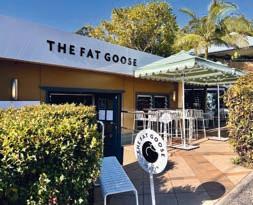
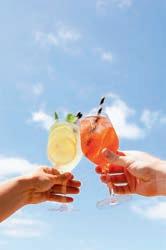
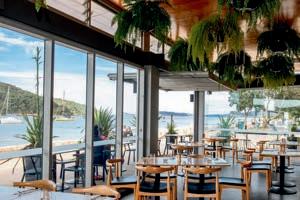


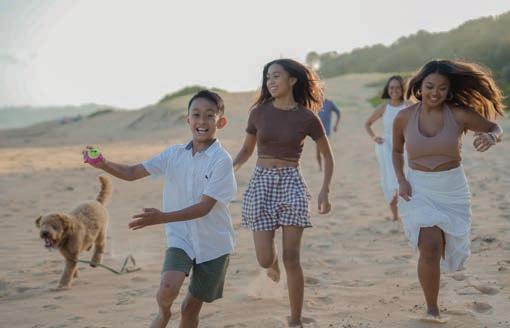
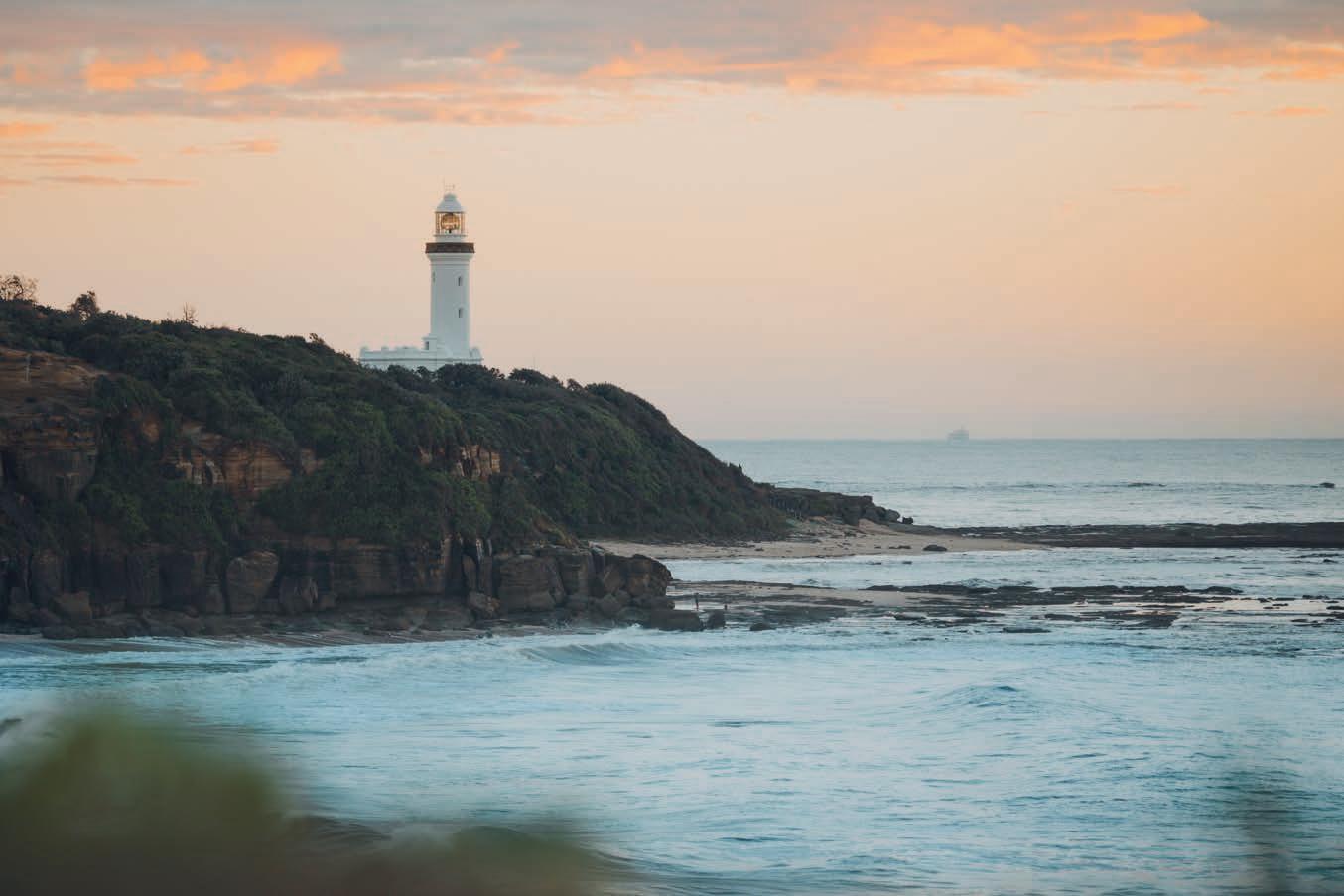
Norah Head Lighthouse keepers had to be ‘male, married and short.’

Joanne Karcz discovers some of the quirky features of this fully functioning Central Coast Lighthouse.
My guide explains, ‘The lighthouse keepers had to be male because they had to be strong. Married to combat loneliness, and short so that they could climb into the small, cramped area between the lens and the light source.’
We’re standing in the entrance hall on the ground floor of Norah Head Lighthouse. Etched in the glass of the door is the saying ‘Once perilous now safe.’ Across the hall is a ghost entrance. Southerly winds blasting through made the entry unworkable and it was bricked off.
Puffing slightly after climbing the 96 stairs that wind around a central cast-iron pole, we step into the lantern room. In 1903, when the lighthouse opened, a vaporised kerosene lamp provided a light source that was visible up to 18 nautical miles (33 km). Today, the light comes from a 1000W halogen globe. 8
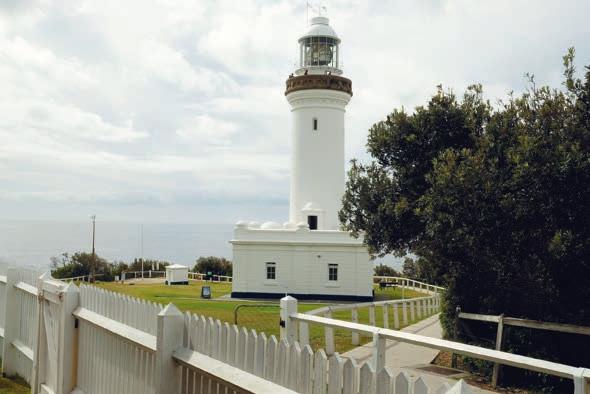
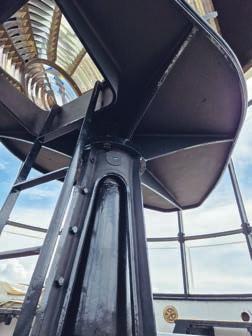
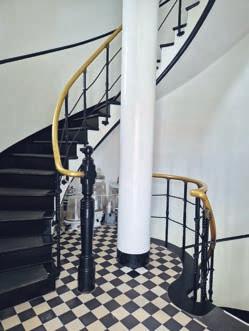
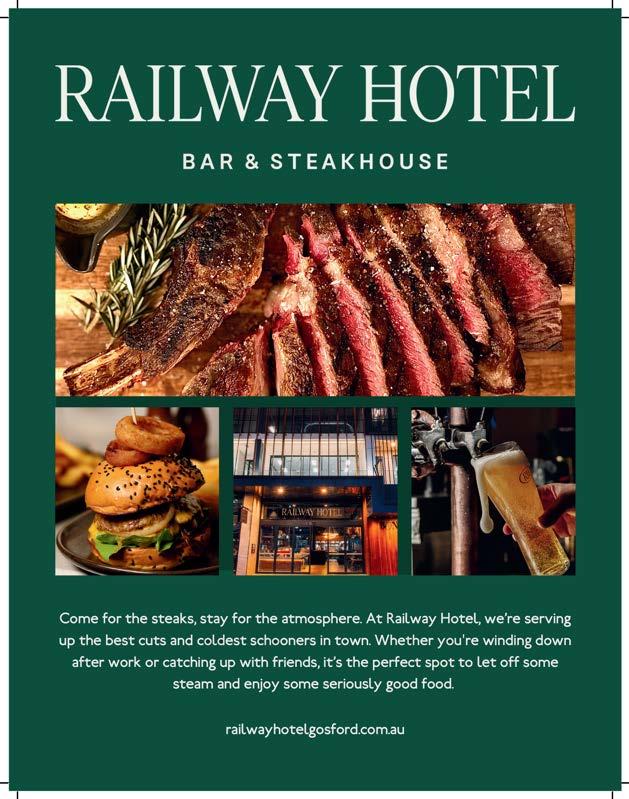
Every lighthouse has a different light signature. At Norah Head, the light flashes every 15 seconds as the lens, consisting of 700 glass prisms, rotates around the lamp. Initially the lens was driven by 300 kg weights lowered through the central pole at a speed controlled by a series of gears. The keeper took an hour to raise the weights by cranking a handle in the lantern room.
During the day, when the lens was still, sunlight, refracted through the lens, had the potential to start a bush fire in the thick bush behind the lighthouse. Curtains were therefore hung to keep the sun out.
Electricity was connected in 1961 and it became fully automated in 1995. These days, the lens turns 24 hours a day. If it stops for any reason, the curtains continue to keep the bush safe.
Watching our heads, we step through the low door onto the bluestone balcony. Big brass plates fit snugly into the bluestone blocks, holding the wall in place. On a clear day, Sydney’s skyline, 74 km to the south, can be seen ‘floating’ above the water off the furthest headland.
Looking north towards Newcastle, beyond the rock platform exposed by the low tide, a white-water wash hints at the treacherous reef below. It was because locals witnessed so many shipwrecks off Norah Head that they petitioned the government to build a lighthouse.
The lighthouse was built layer-by-layer from pre-cast concrete blocks. They were produced on-site with local aggregate. During the day, the distinctive silhouette formed by the domes and ‘mushroom’ caps on the first balcony let sailors know that they were off Norah Head.
The only rectangular window in the barrel (tower) shines red at night. This secondary warning system alerts ships that they are too close to shore. When they are about 7 km offshore and can no longer see the window, they’re safe.
Lighthouse keepers no longer live on site as Transport for NSW (Maritime) maintains the lighthouse, but visitors can experience life as a lighthouse keeper by staying in a keeper’s cottage.
Volunteers run lighthouse tours (weather dependent) from 10 am every day (except Christmas Day and Anzac Day). The last tour is at 1.30 pm. No booking is required.
The kiosk has maps of short walks around the lighthouse. You can stay in one of the three 3-bedroom, 1-bathroom selfcontained cottages which each sleep nine. C
reflectionsholidays.com.au/norah-head-lighthouse/tours

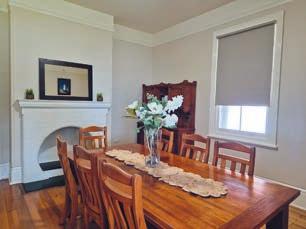
Norah Head was first named by European settlers as Bungaree Norah (Ngurra) after Matthew Flinders’ famous Aboriginal circumnavigation companion. Ngurra is said to signify that it was Bungaree’s ‘place of origin’. It later became known as Norah Head but both versions were in use when the lighthouse was built.
The lighthouse is surrounded by an extensive rock platform that breaks into bomboras-black stone reefs and submerged rock pillars. Coupled with coastal fogs and storms, it is little wonder that at least 36 ships have been known to be wrecked in the area.
Among the shipwrecks are the Ceres in 1836, Anne Maria in 1857, Suffolk in 1859, Esperanza in 1868, Janet Dixon in 1870, Tim Whiffler in 1871 and Gwydir in 1894.
Edward Hargraves, a prominent local resident and ‘father’ of the 1851 Australian Gold Rush, witnessed the tragedy of several shipwrecks near his Noraville home and became a strong advocate for establishing the lighthouse.




Discover Ettalong Beach's premier destination for designer fashion and accessories at Style Me Up. From elegant Gucci handbags to chic Chanel shoes and everything in between, our boutique is your go-to for all your style hire needs.
Style me up.
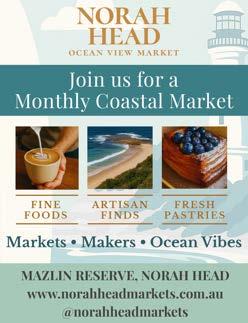

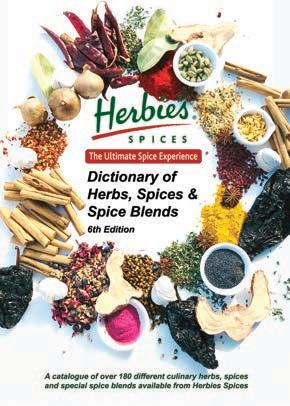

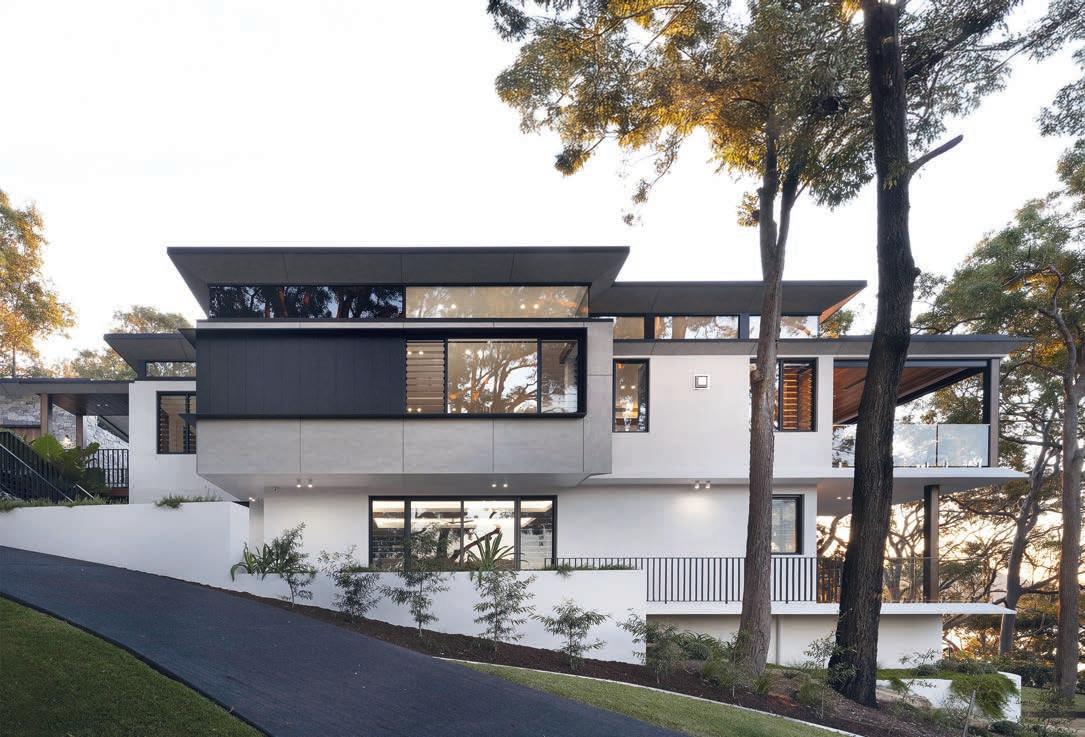


WORDS SHERIDEN RHODES
PHOTOS BRIGID ARNOTT
The Sydney owners of this striking house longed for a sanctuary far from city life when they came across a vacant block in the quiet fishing village of Hardys Bay. They dreamed of building a home with elevated vistas of the sparkling bay with bobbing yachts stretching across Hardys Bay and over to Ettalong Beach. They also wanted to retain the site’s mature blackbutt trees and a significant, protected grey ironbark.
‘We wanted a house that felt like it was rising out of the landscape and soaring amongst the treetops,’ said architect Dave Buehler and Joel Fitzgerald of FBC Architects.
Perched high on a sloping site at Hardys Bay Point (bordering Pretty Beach) the two-level terraced home achieves just that: melding into the tree canopy while offering ever changing water vistas as the sun shifts across the bay.
Sitting sensitively within the landscape, low-maintenance and durable materials were chosen to suit the coastal setting while an arborist identified the site’s most valuable trees. ‘The main thing was maintaining a linked canopy for wildlife,’ Joel says.
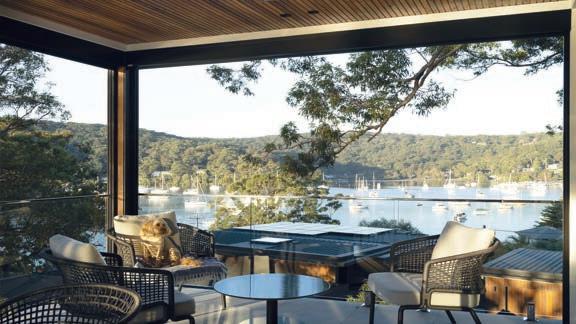
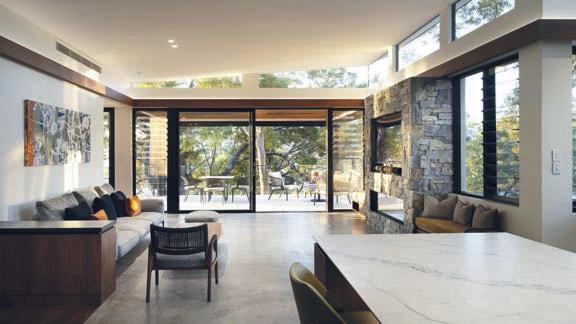


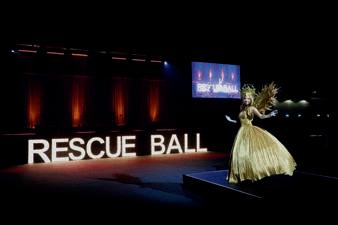





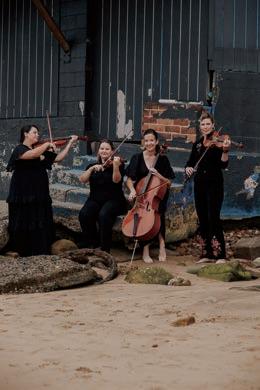



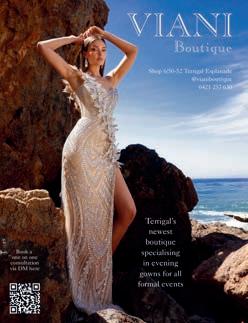

Rising above the landscape with its cantilevered floors and tapered roof forms, the aptly dubbed ‘Rise’ is an arresting example of modern Australian architecture – blending contemporary design with the stunning natural surrounds.
Eye-catching clean lines meet subtle curves, while hard-wearing materials harmonise with soft landscaping for a masculine yet elegant balance. Floor-to-ceiling glass captures panoramic bay views while the use of stone and timber provides warmth and enhances the indooroutdoor connection.
The three-bedroom home offers an easy flow and incorporates a study, wine cellar, workshop, double garage and master suite with walk-in wardrobe and ensuite. Several artworks were commissioned for the new home while a custom-made dining table was crafted from two enormous slabs of spotted gum using an old-school joinery technique with no fixings.
The sloping, fan-shaped block threw up several challenges particularly around access, circulation and ensuring the build footprint maximised the site’s irregular geometry.
Architectural ‘pop-out’ forms projecting outwards make the most of the north-eastern bay views and the 920-square-metre site’s irregular shape. Computer modelling ensured window placements and sightlines looked outward rather than down onto adjacent properties.
Maximising natural light was a priority. Solar studies proved invaluable in demonstrating how orientation and glazing strategies would allow light to filter into key spaces without being overwhelming in summer.
The steep slope meant builder Dan Syddall from Construct Central Coast had to carefully manage logistics – building a pad early in the build to stockpile materials, while neighbours permitted access across their property when needed. ‘We worked hard to minimise the feel that the house is on a steep slope,’ says Joel.
Completed in 2023, Joel says the owners appreciate having a bespoke space tailored to their lifestyle and enjoy the sense of seclusion despite the proximity of neighbouring homes.
Architect FBC Architects
Interior design FBC Architects
Build Construct Central Coast
Landscape Landscapes Unearthed
Joinery + Kitchen Seaside Joinery
Custom dining table Stibuilt
Screens Concept Shade
Tiles MyTileCo
Lining Benchmark Interior Linings
Electrical PNB Electrical
Plumbing AWP All Ways Plumbing
Air Conditioning Airflow Airconditioning
Windows Sublime Aluminium
Roofing All Weather Metal Roofing
Painting Painterz
Stone Sydney Tile Gallery
Benchtop All Stone & Glass
Timber Flooring Skandi Flooring
Stair CJ Black Staircases
Fixtures & Fittings Harvey Norman Commercial
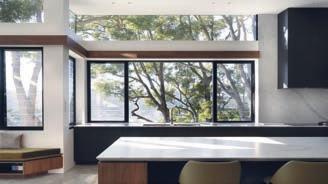
‘It’s a weekender for them to escape to and enjoy time with family. They were involved from start to finish and enjoyed the process as much as we did.’
Taking out top honours in the 2024 HIA Custom Home ($2-3 million Hunter) category, Rise stood out for its consistent quality, considered design and integration within the landscape. ‘It’s an exceptionally wellexecuted home, full of architectural detail and craftsmanship’. C



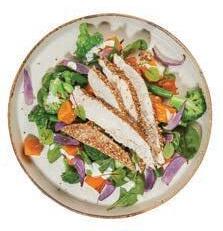
with Michelle Leslie

Interior design is more than just aesthetics; it is the silent language of space that shapes how we experience the built world around us. Every choice – every material, light, and arrangement – has the power to evoke emotion, foster connection and even heal. Design is a bridge between the tangible physical environment and the intangible that is human well-being.
Interiors should nurture a sense of calm, belonging and authenticity. In an age of relentless digital distraction, allow the spaces we inhabit to invite us to pause, to reflect, and reconnect with ourselves and others.
Wood, stone, linen – tactile reminders of the natural world –ground us amid the chaos of modern life. Their textures and even their subtle imperfections speak to our desire for authenticity and impermanence.
Light, too, is a crucial element – its movement and warmth can transform a space from cold to welcoming, from hurried to mindful. That leads us to the importance of silence and space – the ‘ma’ that Japanese design celebrates – because it grants room for thought, for stillness, for presence.
In building interiors, aim for an edited layering of elements, giving every object and material the room to resonate. It’s not about minimalism for minimalism’s sake but about intent and the selection and curation of pieces that bestow value, whether visually, functionally or atmospherically.
A well-crafted interior bears traces of time – faded paint, worn wood, the patina of age – reminding us that beauty lies in impermanence because that’s the way of nature. These signs of life anchor us in a space that feels lived-in and genuine. When designing,
create environments that age gracefully and invite personal narratives, rather than glamorous but sterile showrooms devoid of character.
My approach to interior design is rooted in empathy. I see buildings and spaces as frameworks that should nurture our physical, emotional and spiritual health. The most impactful environments are those that listen – to the land, to natural elements, and to the subtle whispers of comfort and stillness. In doing so, I am reminded that good design isn’t just about how a space looks; it’s about how it makes us feel, how it supports us in becoming more fully ourselves. That is the true art of interior design – an act of care, subtle yet profound. C
Michelle Leslie’s work is well known to many on the Central Coast through her stunning interior designs for Saddles and The Stables at Mt White, Pretty Beach House, as well as many residential interiors here and internationally.
michelleleslie.studio
LEFT Oversized windows framing breathtaking views convey abundance and indulgence, cornerstones of Pretty Beach House’s design language and pillars of its deep resonance.
RIGHT Light’s movement and warmth are transformative elements at this Geelong House by White+Dickson Architects.
BELOW Pretty Beach House is defined by a striking native backdrop, a living, breathing entity that shapes an atmosphere of calm and authenticity.
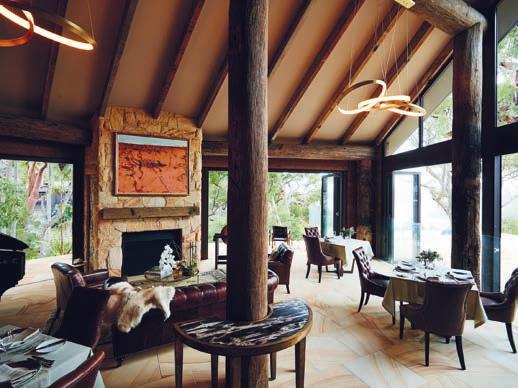
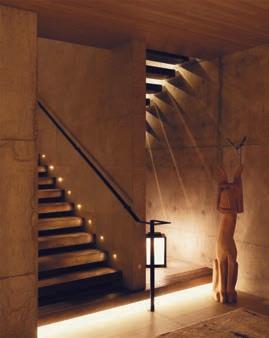
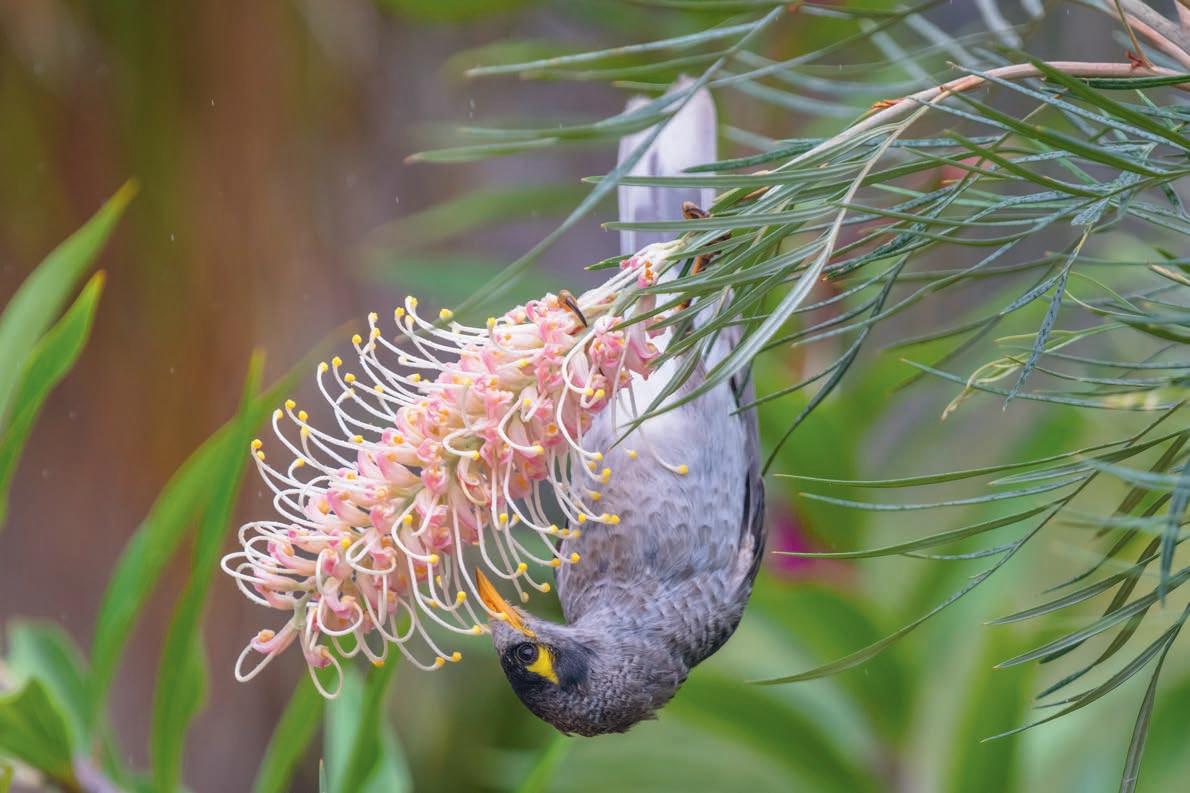
Plant wildflowers to welcome the birds, feed the local wildlife, and fall head over heels for the untamed beauty of the Central Coast.

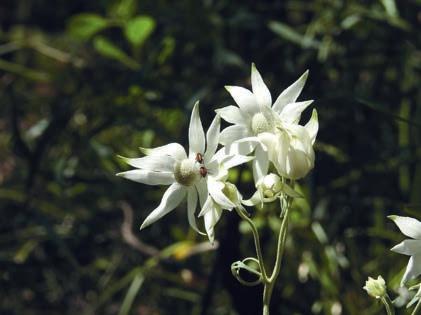
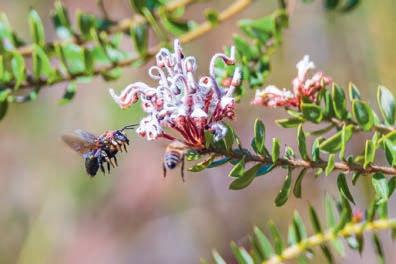
There’s a moment in spring when the bush seems to hold its breath — then suddenly, all at once, it exhales. Out come the starry flannel flowers, delicate and pale, their ivory petals tipped with sage green. Grevilleas burst into bloom like pink fireworks, and banksias bristle with golden candle-brushes. The garden is alive, humming with bees, buzzing with colour, and flitting with feathers. It’s a season of wild beauty, and if you’re lucky, it comes with wattlebirds, a blue wren nesting between the grasses, and maybe — if you’re very lucky — an echidna nosing its way through the mulch.
Gardening with local wildflowers is one of the best ways I know to bring birds and other wildlife right into your backyard. Planting local wildflowers isn’t just about beauty, although there’s plenty of that. It’s about welcoming birds, bees, lizards and pollinators into your patch and creating a garden that sings with life. If you’ve ever heard a lorikeet squawk from the top of a banksia or spotted a family of blue wrens working their way through the mulch munching on insects, you’ll know what I mean. I once watched a family of blue wrens building their nest deep in the branches of a soft emu bush (Eremophila nivea), flickers of blue darting back and forth with twigs. Ready to welcome the little babies at Christmas.
Here on the Central Coast, we’re spoiled with native plants perfectly suited to our soils and climate. With just a little care to get them established, they’ll reward you year after year with flowers, fragrance, texture, and a steady stream of grateful wildlife.
Start with Grevillea sericea, the local pink spider flower. It’s generous with blooms and beloved by spinebills, honeyeaters and wrens. It’s also hardy, compact, and looks stunning with its soft, arching habit. Pair it with a local Banksia ‘Stumpy Gold’ — a compact native that glows with golden brushes and adds drama to any border. Together, they create a natural buffet for nectar-loving birds and a spectacular seasonal show.
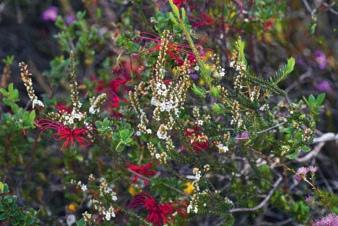
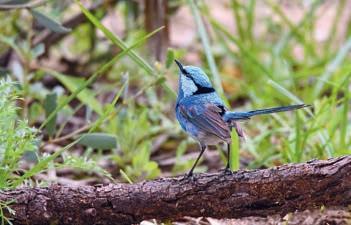
For something a little whimsical, flannel flowers (Actinotus helianthi) are a must. With their silvery foliage and soft-petalled charm, they thrive in sunny, well-drained spots and pots. I always stop in my tracks when I see them catching the morning light, their velvet daisies waving in the breeze. Wax flowers (Philotheca species) are another local treasure. With pink, five-pointed blooms and aromatic foliage, they flower from winter into spring and make excellent fillers or hedging plants
And then there are flowering gums — Corymbia ficifolia cultivars in watermelon pink, tangerine, or crimson red. Originally from Western Australia, the grafted cultivars have taken beautifully to the Central Coast. They’re a magnet for birds and so sculptural, they turn a driveway or verge into a focal point. Combine these with the larger long living kangaroo paws like the ‘landscape series’ bred in Ourimbah and your garden will turn into a smorgasbord of nectar.
Native plants may be tough, but they’ll reward you with more flowers, stronger growth and better shape with a little thoughtful care. After flowering, give plants a gentle trim. A light haircut helps maintain a tidy form and encourages more blooms next season.
Mulch generously with fallen leaves and chunky bark chips to mimic the bush floor, retain moisture and suppress weeds. In spring, feed your plants with a slow-release native fertiliser or a scatter of wellrotted animal manure to give them a gentle nudge into growth.
The key to success is drainage. Most wildflowers hate having their feet wet. Ensure your soil is friable and free-draining, mounding up garden beds where needed to allow for good runoff during heavy rain. Raised beds are especially useful on clay soils or in boggy areas.
Think of your wildflower garden like a meadow or perennial border: layer taller shrubs at the back, weave mid-height species through the centre, and plant in drifts of three, five or seven to create naturallooking swathes that please the eye. Repetition is your friend; it brings cohesion to the planting and allows favourite species to shine.
Don’t be afraid to plant more of what you love and what thrives in your patch. I always choose tubestock or small 140 mm pots. They’re cheaper, easier to establish, and let me experiment widely to discover what truly sings in my soil.
Finally, support your local wildflower nurseries, they know the plants that work best in our region and always have hidden gems worth discovering. Plus, they’re full of passionate growers who love a good garden chat.
This is the joy of gardening wild. It’s not about control, it’s about connection. Let your garden be a little untamed, and nature will reward you in the most unexpected ways. C
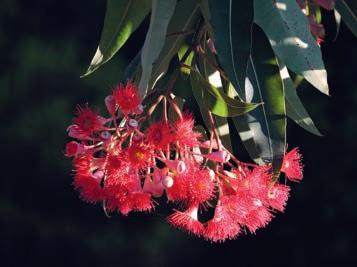
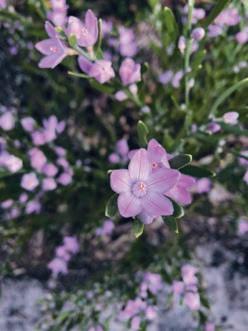
At this time of year, the bush is a kaleidoscope of new life. It will leave you inspired to bring the nature and wildflowers into your garden:
Bouddi Coastal Walk
Spring along the clifftops is unforgettable — flannel flowers, pink wax blooms and sweeping ocean views. Start from Putty Beach and walk toward Little Beach for a scenic wildflower showcase.
Strickland State Forest
This historic forest near Narara is a springtime gem, with native orchids, wattles, grevilleas and shady fern gullies, plus picnic spots and birdwatching galore.

Munmorah State Conservation Area

Explore the Moonee Beach or Palms circuits for banksias, tea-trees and waratahs. The coastal heathland comes alive with colour and birdlife and flannel flowers!
Kincumba Mountain Reserve
A haven for flannel flowers, boronias and rock-loving natives, this plateau walk offers bush beauty and valley views just minutes from suburbia.
Wyrrabalong National Park
Both the north and south sections offer fantastic spring walks. Try the Red Gum Trail or the Coast Track from Bateau Bay where wildflowers bloom against a backdrop of crashing waves.
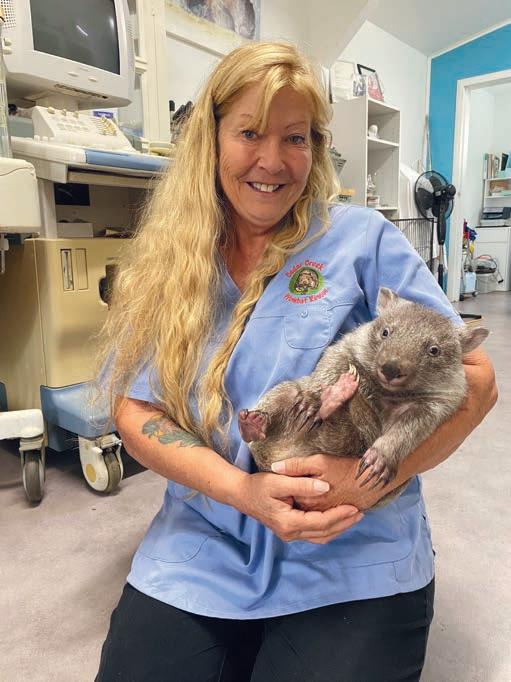
Tucked away in the bushland of Cedar Creek, south-west of Cessnock, lies a sanctuary unlike any other, Cedar Creek Wombat Rescue.
Founded by Roz Holme and her husband Kevin, it’s a lifeline for one of Australia’s most beloved native creatures.
For decades, Roz has lived and breathed wombat care, battling the scourge of mange and giving these burrowing marsupials a second chance at life.
‘I’ve been looking after wildlife for 40 years,’ Roz says. ‘I was born into it. My parents cared for wildlife, and when I got married, my husband and I took it even further.’
Cedar Creek Wombat Rescue has evolved from a labour of love into a fully fledged hospital thanks to Roz’s tireless efforts. When she first started, mange was considered a death sentence for wombats.
‘No one wanted to treat them, and euthanasia was the only option. So I started training vets and vet nurses, because it is treatable.’
Over the years, Roz forged connections with local veterinarians who helped her establish the hospital. But the real turning point came when, during a chance meeting, the Kinder chocolate company asked how it could help. ‘I said I wanted a proper hospital, and they made it happen. It cost a lot, but it’s changed everything.’
The hospital is designed for around-the-clock care. Roz’s own bedroom is connected to the facility, allowing her to respond to emergencies without stepping outside. A separate vet room means visiting veterinarians can stay on-site. ‘I’ve put my whole life on hold for wombats,’ Roz admits. ‘Everything here is built for them – to keep them safe and to make sure I can do the best job possible.’
With capacity for 30 wombats at a time, the work never stops.
‘Every week, I think, ‘I need to build a new pen, a new ICU unit.’
Demand soared during the 2019 bushfires, when the hospital was inundated with injured and orphaned wombats. ‘It was really difficult, trying to care for them while also out fighting fires,’ she says.
‘You can only take in so many critically ill animals before you start having problems.’
Mange remains the biggest threat to wombats in the region, particularly in Mangrove Mountain, Yarramalong and Cedar Brush Creek. ‘On the Central Coast and in the Hunter Valley, if someone calls about a wombat with mange, I’ll meet them, assess the animal, and bring it home if I can know I can help.’
Roz also works with zoos, where wombats often struggle to thrive.
‘I bring them here and dehumanise them, so they have a shot at being wild again.’ She monitors their progress carefully, waiting until they weigh at least 20 kg and have learned to dig a burrow before considering release. ‘You wouldn’t let one go that can’t dig. It wouldn’t survive.’

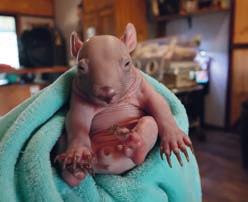
One of Roz’s most notable guests is Wilbur, who came to stay after a stint at the Australian Reptile Park last year. ‘He is the most beautiful wombat. He’ll be released in a few more months, once he has shown me he can dig.’
Once ready, the wombats are soft-released, meaning they can come and go from their enclosure at their own pace. ‘There’s always food here if they need it,’ Roz says. ‘They know it’s safe.’
Caring for wombats isn’t cheap. The hospital’s weekly food bill runs to $350, covering grain, roo pellets and grassy hay, which is especially costly. ‘We’re trying to plant native grasses on our 200-acre property so there’s always something for them to eat.’
Supporters have helped in other ways, too. A generous donor provided a mobile home, which will become a manager’s cottage once solar power and fencing are installed. ‘I stay there sometimes, and when you walk out onto the veranda, you’re surrounded by wildlife –there are always kangaroos in the paddock.’
Cedar Creek Wombat Rescue is more than just a hospital, it’s a testament to one woman’s unwavering dedication to Australia’s wildlife. ‘I’ve had my family, I’ve had my life. Now, everything is for the wombats,’ Roz says. ‘I’ll do this until I die.’
But she can’t do it alone. Financial donations and volunteers are always needed to keep the hospital running and to continue the fight against mange. If you want to help, visit Cedar Creek Wombat Rescue and be part of this incredible mission to save one of Australia’s most iconic creatures.
cedarcreekwombatrescue.com


Holi is filled with colour – powder bombs of colour – red for love and fertility; blue for Krishna; green for new beginnings; and yellow for the spice of India, turmeric.
The festival lasts night and day, with a bonfire the day before to burn away evil so that good can survive. It marks the arrival of spring, emphasising hope, positivity and renewed energy, and we can all do with a little more of that in our lives.
We love celebrating Holi in the majestic ‘blue city’ of Jodhpur at a very special ‘colour-me-pink’ event. While you’re there, explore the backroads of Rajasthan, the Land of Kings, witness the sunset over the Taj Mahal, play and walk with elephants at a wilderness rescue camp, stay in a rural village and end your journey in the ‘city of lakes’, Udaipur, in a grand palace!
Check out the luxury 14-night, 5-star highly personalised, small-group tour offered by TIKKA TOURS from 24 February to 10 March 2026.
Read more at tikkatours.com.au/raj-holi
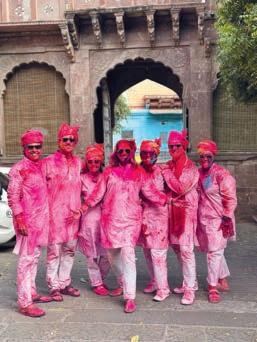
, the
Diwali, spread over five glorious days, is one of the most widely celebrated festivals and marks the start of the Hindu New Year. Celebrated by Hindu, Sikh and Jain communities, it’s known as the Festival of Light when people decorate their homes, shops and public buildings with fairy lights, candles and oil lights to help Laxmi, the Goddess of Wealth find her way to their homes. You’ll often see intricate rangoli patterns in coloured powders and flowers at the entrance to homes to welcome the gods. To end each day in spectacular fashion, fireworks light up the sky at night to symbolise the victory of light over darkness.
The markets and bazaars are abuzz with shoppers buying gifts, new clothes, sweets and even more decorations. Diwali is also about spending time with family, and communities coming together to celebrate with concerts, dance performances and theatre shows. And what would a festival and family time be without feasts built around the finest local foods and sweet treats.
TIKKA TOURS (located in Kincumber) has a 14-night, highly personalised, small-group tour from 8 October to 22 October this year. Your nights will be spent in 5-star boutique and heritage hotels as well as some million-star deluxe glamping. Your journey celebrates the Festival of Lights in the City of Lakes, Udaipur, as well as taking you to Rajasthan with its ancient traditions, local markets, villages and cities, and of course the tantalising Rajasthani cuisine. You will even stay at The Best Exotic Marigold Hotel! C Learn more at tikkatours.com.au/royal-rajasthan








TIKKA TOURS 0466 910 067
claudia@tikkatours.com.au www.tikkatours.com.au


HUT 0408 631 695
glenn@thetravellershutcom.au 5a 39 Avoca Drive Kincumber

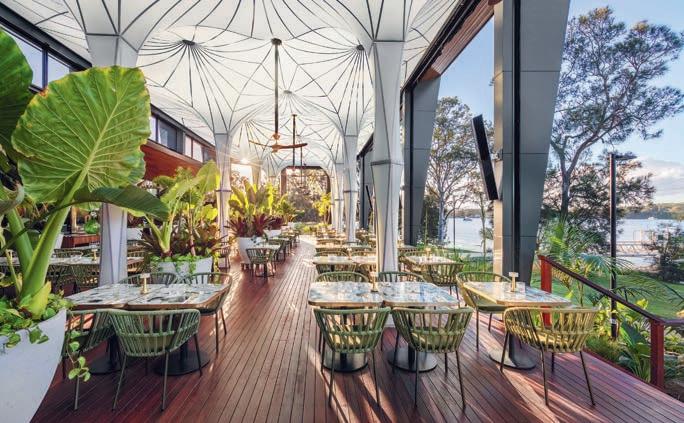
Particularly if you live in the northern part of the Central Coast, Lake Macquarie may be closer than some of the southern Central Coast attractions. Or, wherever you live, Lake Macquarie is a nice weekend drive to some superb restaurants or on-water activities. Here are a few of our favourites.
8 at Trinity, Morisset
At the top of anyone’s list for that memorable occasion where you want a one-of-a-kind experience, 8 at Trinity will have you feeling special the minute you step beneath its soaring canopies and wander between its lush indoor greenery. Located on the waterfront beside the Trinity Point Marina, the restaurant offers an unforgettable Australian dining experience that’s both casual and sumptuous.
8attrinitypoint.com.au
If it’s fresh seafood you’re after in a lakeside setting for lunch, or to watch a brilliant sunset over the calm waters, head to Tinta to relax or celebrate with friends and family. The wine list features some of our neighbouring Hunter Valley’s finest. Or wind down from the week with the bartender’s very special cocktails.
tintabelmont.com.au
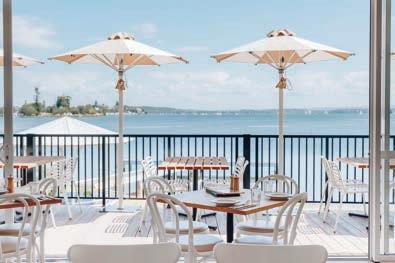
Emerson on the Lake, Toronto Chef Emerson Rodriguez is just one ingredient that make this restaurant within the Royal Motor Yacht Club exceptional. You may remember him from 13 years at his Emerson’s restaurant in Pokolbin. Here, against a stunning lakeside backdrop, he’s chosen a tempting, modern Australian cuisine, with local flavours and innovative creations. The rustle of furled sails as the breeze threads like wind chimes through boat riggings, comes at no extra cost.
emersonsrestaurant.com.au
Mr Sister Coffee, Speers Point
Ask a local where they go for coffee, and they’re likely to say, ‘Mr Sister’. Add to that, freshly made pastries and cakes, and a Reuben sandwich that will make you nostalgic for New York, even if you’ve never been there!
facebook.com/mrsistercoffee
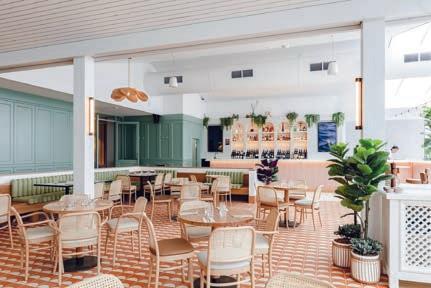
Drink & Dine, Belmont
Named after a 30-tonne schooner skippered by Captain William Reid who mistakenly became the first European to sail into Lake Macquarie, it’s why you’ll find tantalising Martha wines by David Hook and 30 Tonne Mistake Lager here. Martha’s cooking features Mediterranean Mibrasa ovens, a primitive culinary method over hot coals that produces authentic flavours. It’s the perfect spot for indoor or outdoor shared-style dining.
marthadrinkanddine.com.au
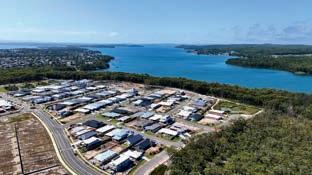
Visit cranganbay.com.au to explore our newest stage 5 land release! 1800 838 160

Lakeside Lifestyle, Inspired by Nature
Explore this coastal land estate
Nestled on the shores of Lake Macquarie and surrounded by national park, Crangan Bay offers an idyllic lakeside lifestyle unsurpassed by any other land estate on the Central Coast.
Looking to build now or simply wanting to secure a lot off the plan, enquire today to explore an array of lot options, the perfect canvas for your dream home. Wish you were here!

If you fancy an eco-adventure boat cruise, CoastXP will take you on whale watching ventures, coastline cruising and guided nature walks along the Lake Macquarie and Newcastle coastline. You’ll hear fascinating and informed commentary focusing on the marine life, local geology, Aboriginal heritage and maritime history. Or opt for the TINTA lunch tour package after you’ve worked up an appetite.
coastxp.com

Even if you’ve never felt the urge to kayak before, this night kayak tour will convert you into an instant aficionado. To let you enjoy the spectacle of marine life, your state-of-the-art, clear kayak is custom-fitted with lights that glow into the water. Your super friendly guides share stories and keep you safe, so be prepared to be entertained, educated and amazed.
showtimekayaking.com.au
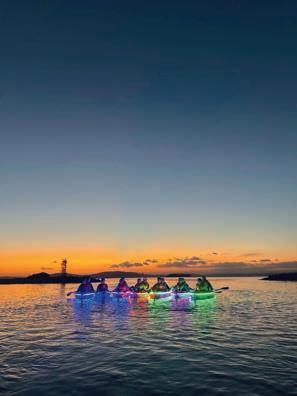
Go on, we know you’ve always wanted to do it: an Efoiling Fliteboard experience where you rise on a hydrofoil to fly above the water. No wind, no waves, no towing required! Or hire a kayak, a SUP or boat. eBikes are also available for the landlubbers among us.
trinitypointmarina.com.au/watersports
‘In a hyperbaric oxygen chamber, you are breathing up to 97 per cent pure oxygen in a pressurised environment that’s equal in pressure to a 10-metre underwater dive,’ says Chris Youakim, wellness chiropractor and oxygen technician at Coast Oxygen. ‘This allows the oxygen to dissolve into your blood plasma at 20 to 30 times higher concentration, letting it reach vital organs and tissues that are often lacking circulation.
‘The therapy stimulates the body’s healing, increases stamina and immunity and, interestingly, also promotes relaxation. And if that’s not enough, as one of nature’s best antioxidants and antibiotics, oxygen slows down the ageing process, speeds up recovery and enhances cognitive function.
‘The brain weighs only two per cent of our body weight but uses more than 20 per cent of the body’s oxygen. That’s why oxygen therapy is so great at restoring neurodegenerative brain conditions, autoimmune diseases and many other health concerns.’
Stepping inside the oxygen chamber you lie down or sit up, and put on an oxygen mask. As the oxygen flow increases and the chamber pressurises, the feeling is a little like going up in a plane or underwater diving.

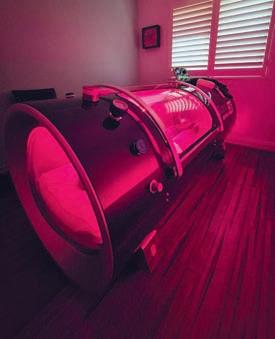
You can read a book or a copy of COAST magazine ... or, like someone I know (no names), you might even fall asleep as you enter a deep state of rest and relaxation.
‘It’s non-invasive and the chamber is filled with filtered ambient air for added safety and effectiveness,’ says Chris. ‘Our chambers also include red light and infrared therapy, which offer a unique synergistic effect that supports skin rejuvenation, circulation, energy production and cellular repair.
‘The great thing about oxygen therapy is that we know the body is designed to heal itself when it has what it needs. And there’s nothing we need more than oxygen! Simply put “Oxygen is life”.’
Chris and his partner, Vicki Jacobsen, who is a biodynamic craniosacral therapist, often combine hyperbaric oxygen therapy with spinal care and general wellbeing in chronic pain management, mental health and stress.
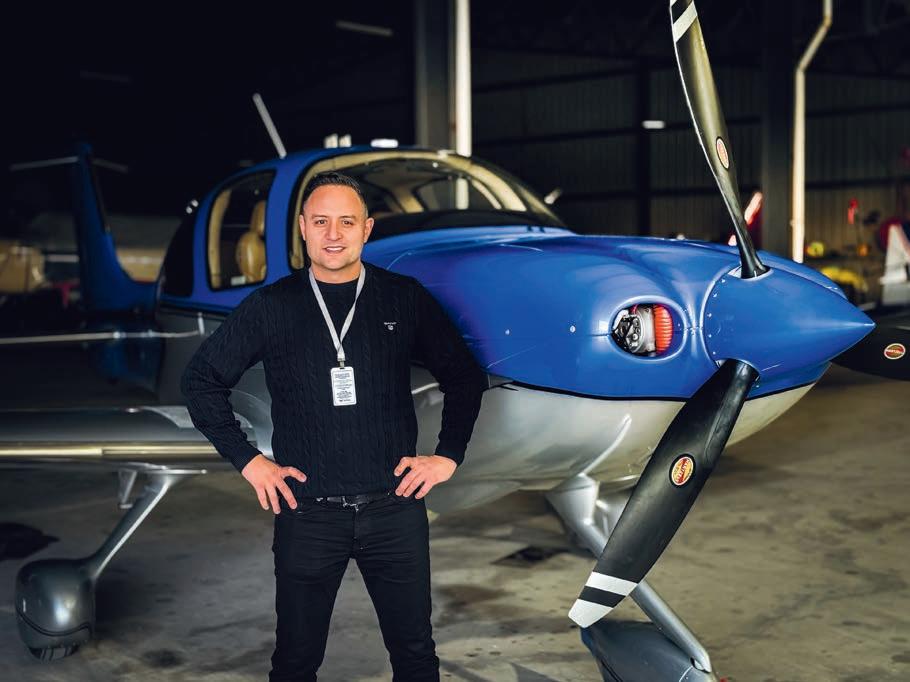


Dr Ned Restom’s first love was flying and it’s something he’s been able to combine with his second love: dentistry. It’s not a combination that readily spring to mind, but then Ned doesn’t do things by halves.
‘I first started flying when I was 17 but stopped when I needed to concentrate on my university studies,’ he says. ‘I love the freedom, the challenges, the fact that every single flight is different.’
When he graduated in dentistry in 2004, he did the first unexpected thing in his career. He managed to obtain an, almost unheard of, early post-graduation registration for a posting to the New England area to help alleviate their regional dentistry waiting lists. Ned and his colleagues saw 200 patients in his first two weeks there.
‘That’s what got me interested in the need for regional clinics,’ he says.
‘I was working Mondays to Thursdays in Tamworth, Armidale and Inverell, but my family was back in Sydney. I saw an ad in The Trading Post for a clinic in Woy Woy that was looking for a dentist, part time. And I thought I could work there Fridays and Saturdays and then head back to New England. So for the next couple of years, I flew between the two regions.’
By 2006, Ned knew his heart belonged on the Central Coast and he bought an apartment in Terrigal. The following year he opened his first Smile On clinic in Lisarow. Three years later, the Smile On dental clinic in Avoca Beach followed.
‘Just weeks after we opened in Avoca, I had a motorbike accident and couldn’t work for two years after that,’ he says, downplaying the horrific accident. ‘I was able to get locums to work in my clinics but decided the best thing I could do, was to go back to university to study and upskill my dentistry abilities to the next level.’

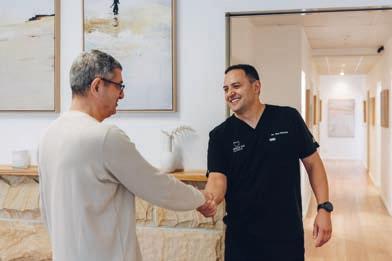
Ned completed a Masters program in Implantology in Australia and then a US Masters program, becoming one of only four Australians to hold a diplomate of the American Board of Oral Implantology.
‘I got the US qualification by travelling to America for two weeks every month, then heading back home. It was a bit extravagant, financially, but it changed my entire career because the technology I was learning was so advanced.
‘I borrowed money with my partners, obtained the rights to the program in Australia, and we set up the Australian Implant Academy (AIA). It was designed to train 300 dentists per year with top clinicians from around the world coming to teach implant technology, fullmouth rehabilitation and more. Then Covid hit. Then I was diagnosed with testicular cancer,’ he says as if that was just a small setback.
During his (successful) treatment, Ned returned to his first love: flying. Again, he didn’t do things by halves, having bought a Cirrus SR22 G6, single engine plane.
‘It’s an amazing plane,’ says Ned. ‘It has an aircraft-parachute which means the plane can get back to earth safely should anything happen to your one engine. And I can get to regional areas like Dubbo in 50 minutes – less than it takes to drive from the Central Coast to Sydney or Newcastle.
‘Instrument flying makes it much more challenging and more satisfying. You need to be disciplined, always planning, alert, ready for any eventualities. It’s a lot like dentistry! And the other thing they have in common is that you need to keep your skills current; you can’t not
fly or not practise your skills for a few months in either discipline and expect to remain at the top of your game.’
Ned’s flying sparked the idea of opening more regional dental clinics, employing and upskilling local dentists. The man who doesn’t do things by halves has now opened 24 Smile On clinics, mostly in regional areas from Dubbo to Griffith, and from Gunnedah to the Sunshine Coast.
‘For complex or critical cases, I need to be able to get to those regions as quickly as possible. Having my own plane and being able to fly out of Warnervale Airport makes that possible.’
So, can Ned sit back and just enjoy flying between his clinics? No, remember this is a man who doesn’t do things like other earthbound mortals. In July, he opened a purpose-built, fully functional Smile On dental hospital and implantology training centre in Wamberal, capable of advanced dental procedures requiring day-surgery with full anaesthesia, as well as cosmetic and implant dentistry, Smile On Straighter, and more.
‘It means patients don’t need to travel to a hospital in Newcastle or Sydney. And having our own lab, surgical facility and support teams together means better communications, faster and better care for our patients.
‘We started on the Central Coast and it means a lot to build something unique, on this scale and impact here at home.’
It’s enough to make Ned smile, but don’t believe for a minute, that this is all that’s on his wide horizon! C
smileon.com.au

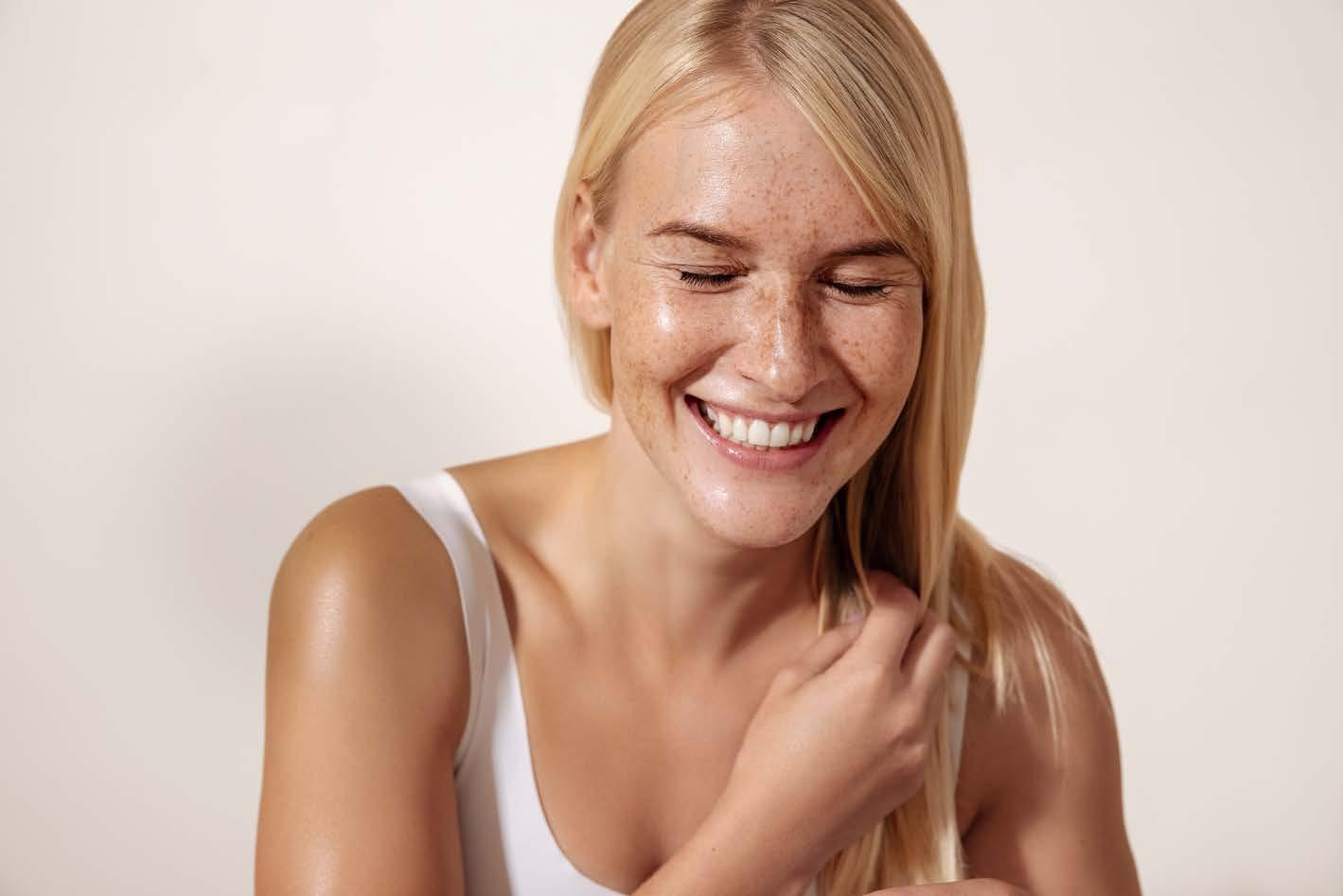


Newcastle will cement its place as a leading arts and cultural hub when its reimagined gallery opens in spring, writes Jennifer Ennion.
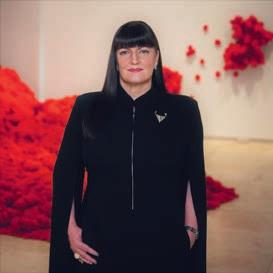
Artworks by John Olsen AO OBE, Sir William Dobell OBE and Margaret Olley AC will soon get the stunning exhibition space they deserve when the community is given its first look inside the reimagined Newcastle Art Gallery in September. After more than 40 years, the gallery is undergoing a major expansion, which will see it more than double its exhibition space. That means there will be 13 galleries honouring iconic works by beloved big-name Australian artists. Newcastle Art Gallery Director Lauretta Morton OAM says the gallery’s significant collection was a major driving force behind the expansion.
‘We have over 7,000 works of art and it is arguably one of the most important collections outside of the State Gallery,’ Morton says. ‘To be able to finally get our icons on display on a permanent rotation is going to be really exciting.’
Those icons include the only John Olsen ceiling that’s actually installed as a ceiling in one of the gallery spaces. Olsen has strong links to the community, having been born around the corner from the gallery. Dobell was also born a couple of streets away, while Olley lived in Newcastle for several years.
Along with these historically important works, there will be international shows in the upstairs galleries to ensure there is something for everyone. The expansion also means the gallery will have a dedicated retail shop and its first ever permanent cafe, making it a complete destination for locals and tourists. There will also be a new learning space that can be converted into a theatrette and workshop area for inclusive adult and children’s programs. Morton says the expansion is about maturing as a gallery.
‘We’re just growing up, is how I like to describe it,’ she says. ‘We’re turning into a modern art gallery that the city and region deserves…’
The gallery’s slogan is ‘locally grounded, nationally engaged and globally minded’, and bringing that to life are an impressive number of stakeholders. The Australian Government has contributed $5 million toward the expansion, which has been matched by the NSW Government. The Newcastle Art Gallery Foundation has funded $12 million of the expansion through the Valerie and John Ryan bequest, Margaret Olley Trust and community donations over many years, with fundraising ongoing for an additional $1 million.

‘To have all levels of government, as well as huge community support is really significant for this project,’ says Morton. ‘It absolutely takes a village,’ she says with a laugh, and it’s the ‘village’ that’s at the front of Morton’s mind. She hopes Newcastle Art Gallery is a space the entire community will enjoy.
‘I think galleries are a safe and welcoming place, and I think art is for everyone,’ Morton says.
She plans to have extended gallery hours, including Friday nights so people can drop in after work to see a program or hear music. Her idea is to ‘kind of push the boundaries that it’s not all about the high art’. After all, it’s a public art gallery.
‘We’re here for everyone to come and enjoy their collection,’ Morton says. ‘We’re just the custodian of that collection…’ C
nag.org.au
Newcastle Art Gallery is scheduled to open for a first look at the new spaces on 26 September, 2025.
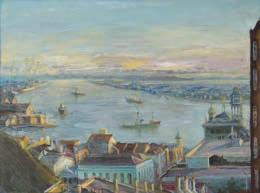
LEFT William Dobell, Portrait of a Strapper, 1941. Newcastle Art Gallery, Australia, gift of Captain Neil McEacharn 1959. © Sir William Dobell Art Foundation/Copyright Agency. Image courtesy Newcastle Art Gallery.
BELOW John Olsen, Life Burst, 1964. Newcastle Art Gallery, Australia, gift of the Sir William Dobell Art Foundation 1976. © the estate of the artist/Copyright Agency. Image courtesy Newcastle Art Gallery.

22 November to 11 February
To help celebrate Gosford Regional Gallery’s 25th anniversary, the Archibald Prize for portrait painting from the Art Gallery of NSW is coming to Gosford in November.
Now in its 34th year, the finalists have rarely toured to the Central Coast.
Australia’s most celebrated and often controversial art award will again raise eyebrows (and even heated discussions). Julie Fragar, a four-time finalist in the Archibald won for her other-worldly portrait of fellow artist and close friend, Justene Williams. Julie’s was one of 904 entries and was chosen unanimously by the AGNSW’s Board of Trustees.
The popular Packing Room Prize for a portrait by Abdul Abdullah, ‘No mountain high enough’ will also be exhibited. The packers say it depicts Jason Phu as a lone ranger and an intrepid jokester always involved in a dozen conversations at once while also navigating the rocky terrain of today’s social climate.
Other finalists include portaits of Hugo Weaving, Katie Noonan, Cressida Campbell, Nicole and Antonia Kidman, Ken Done, Jackie O, Reg Mombassa and barrister Sue Chrysanthou. C gosfordregionalgallery.com

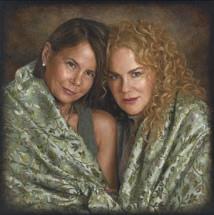

THIS PAGE, CLOCKWISE FROM TOP: Jaq Grantford, Sisters, oil on canvas, 67.5 x 167.5 cm Sally Ryan, Lette loose, oil on board, 120.9 x 90 cm
Winner of the Archibald Prize 2025: Julie Fragar, Flagship Mother Multiverse (Justene), oil on canvas, 240 x 180.4 cm
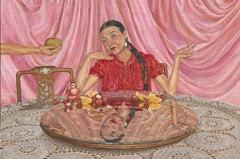
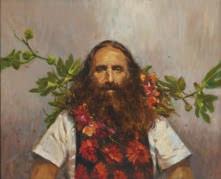
THIS PAGE, CLOCKWISE FROM TOP:
Whitney Duan, Banquet (Rainbow Chan), oil, sand and gold leaf on canvas, 119.6 x 180 cm
Natasha Walsh, The Yellow Odalisque of Brunswick, oil on copper, 53.2 x 49.9 cm
Evan Shipard, The green man, oil on linen, 66.4 x 81.3 cm

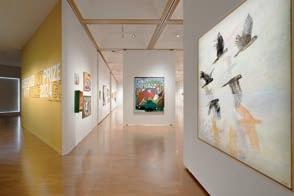
Gosford Regional Gallery & Edogawa Commemorative Garden
The Gosford Art Prize is an annual award that attracts entries from across Australia. The Prize is open to all Australian artists working in any medium and attracts submissions that show a breadth of artistic excellence and display a diverse array of contemporary techniques and conceptual concerns.
This year the prize pool has increased to over $55,000 and presents the selected winner with a prize of $25,000 in recognition of the 25th anniversary of Gosford Regional Gallery. $10,000 will be awarded to a First Nations artist and $10,000 to a Ceramic based artwork. The inaugural Moving Image Art Award, also valued at $10,000, will be presented to an artist working in any moving digital film/screen based artwork.
6 September - 9 November 2025
Gosford Regional Gallery

36 Webb Street, East Gosford, New South Wales, 2250 www.gosfordregionalgallery.com 02 4304 7550 Open 9:30am - 4pm daily closed Good Friday.
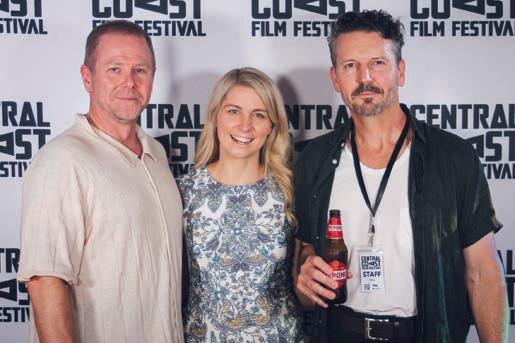
Well maybe we’re not yet rivalling the Big Four, but something cinematic is definitely stirring interest on the Central Coast in the sea breezes and salty air. This November, the laid-back seaside village of Ettalong Beach will roll out the red carpet to celebrate independent filmmakers and storytelling from around the world as the Central Coast Film Festival returns for its second year, lighting up screens and imaginations from 1-9 November.
Set in the charming and quirky multi-theatre Cinema Paradiso, the festival offers an eclectic, diverse and vibrant program spanning feature films, shorts, experimental pieces, documentaries, animations, and even music videos.
Festival Director Shane Emmett, a Coast local and award-winning filmmaker, says last year’s debut exceeded expectations. ‘The Central Coast Film Festival 2024 was a revelation to the coastal community. The cinemas were packed every night and the foyers abuzz with international networking, and we couldn’t be more excited to bring it back in 2025.’
Backed by more than $20,000 in prizes and sponsorships, the 2025 Festival has announced two new awards – Central Coast Filmmaker of the Year and Young Central Coast Filmmaker of the Year – aimed at spotlighting and supporting the next generation of storytellers.
Whether you’re a filmmaker, a film buff, or simply someone who loves the alchemy of creativity and community, this is an experience worth travelling for. Dress: Coastal shirt with black tie (optional)!
Submissions are open until 1 September, so there’s still time to get your project in the mix or plan your trip to coincide with a week of cinematic discovery.
Grab your popcorn (and maybe your passport for the mind) and make a date with the Central Coast this November. It’s more than a film festival – it’s a celebration of storytelling, coastal style, in a place Sundance, Cannes, Venice and Tribeca might well envy. C


Musical/Comedy
Comedy

Saturday 16 August, 2pm
“The Woman Who Saved Australia” but couldn’t save herself; a musical journey.
Sunday 17 August, 2pm
Showcasing some of Australia’s funniest comedians with disability or chronic illness.

Musical
Theatre/Comedy
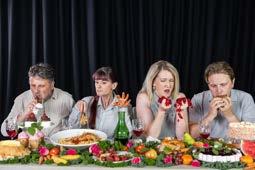
Saturday 23 August 7.30pm
Charlie, Elsa and Fay take you on a musical journey back to 1940’s post war Perth, and a time of curfews and the fear of arrest for ‘consorting’.
Saturday 13 September 7.30pm
Two couples meet to discuss an incident between their sons. What starts as a civilised discussion with espresso, clafoutis and small talk, quickly descends into a gloves off mess.
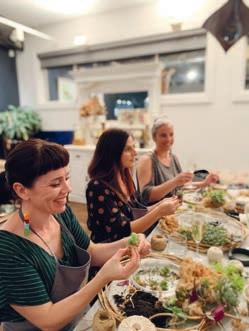
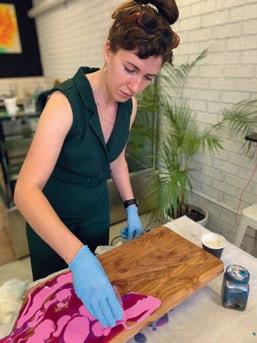
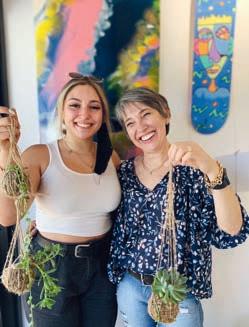
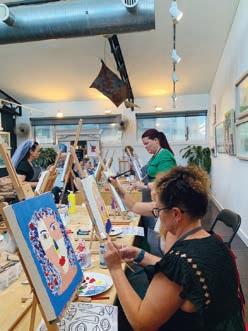
Central Coast locals are embracing arts and craft with a rise in creative classes, says Jennifer Ennion.
Whether you’re learning to crochet or throw a bowl on a potter’s wheel, it seems we’re in the middle of a crafting boom, and our desire to disconnect to reconnect is largely the reason. Luka Vockins of Central Coast Creative Hub says people are seeking to connect through creativity.
‘You don’t have to speak the same language, you don’t have to have the same background, but it’s like music, you just connect,’ Vockins says.
Vockins started Central Coast Creative Hub in 2017 after moving here from Cape Town, South Africa. At the time, craft classes were hard to come by, but when local markets were cancelled during the Covid years, creatives began attending Vockins’ workshops, learning how to turn their products into experiences.
‘I tried to show them it’s about the process not the product,’ says Vockins, who covers fabric dying, resin art, lino carving and more. ‘People wanted to connect by learning how to do these things,’ she adds.
Half a decade later, the Central Coast has more classes on offer with a wider variety of craft disciplines, and a growing number of residents attending them.
A reconfiguring of craft businesses, and a want for community, are not the only reasons many of us are spending our weekends threading needles or perusing Eckersley’s art sale. We’re also taking action, literally, to remove ourselves from digital noise and daily stress.
‘The main comment our students make after attending a workshop is the word ‘therapeutic’,’ says Centered Ceramics co-owner Guy Jamieson, ‘and I'm certain all spaces running art workshops would hear similar comments.’
Jamieson says his Umina ceramics studio, which he runs with his wife Jennifer, has seen a steady increase in bookings over the past few months across all areas. Their eight-week term classes, which have found a solid community of potters, have been particularly popular. Centered Ceramics also runs a stack of short workshops, and Jamieson says they offer more than an introduction to pottery.
‘When we designed our studio space, our intention was to give people the opportunity to escape from all their life distractions and experience some muddy 'me time',’ he says.
‘Using your hands to create a cup or bowl or sculpture is all encompassing. The everyday distractions fall away and all that matters is the texture and shape of the clay.’
So what are we spending our time learning? Vockins, who runs a gamut of workshops out of One Lucky Duck Cafe in Woy Woy, Central Coast libraries and Scout halls, says resin art is hugely popular,
largely because the product is more readily available than it used to be. Kokedama, Japanese plant binding, is also a favourite of class attendees. Looking ahead, Vockins expects ceramics to continue its upward trend, with many locals renting out their kilns.
Along with our desire for community and to switch off, Vockins attributes the resurgence of craft to such pursuits becoming culturally acceptable, once again.
‘It’s not just the artsy fartsy people, it’s all people…’ she says of those showing interest.
‘Creativity is a form of play, so we all still have that in us. That’s how we learn. Instead of it being just ‘crafting’, it’s become a form of therapy.’ C
Central Coast Creative Hub runs a large range of workshops that teach participants about lino carving, resin art, macrame and wreath making. They also offer mobile kids’ craft parties. centralcoastcreativehub.com.au
Gosford Regional Gallery is renowned for its creative classes, including term painting sessions for children and adults, life drawing evenings, illustration and storytelling. gosfordregionalgallery.com
Central Coast Council puts on a great selection of craft workshops across its libraries. They include lino printing, making ornamental Hug-a-dreamcatchers, learning Cricut [pronounced ‘crick-it’] vinyl-cutting techniques and jewellery making.
libraries.centralcoast.nsw.gov.au
Centered Ceramics is a beautiful studio all about clay art, with workshops on making coil pots, figurative sculptures, wheel-thrown cups and bowls, and even mouse houses for lovers of whimsy. centeredceramics.com.au
Hug-a-Bear Workshop at the Davo RSL lets kids make talking teddys. Suitable for ages 5 years and up.
lovecentralcoast.com/events/hug-a-bear-workshop
House of Ellery, Wyong runs workshops in pyrography (calligraphy burnt in wood), soy candle-making, textured flower art, resin tray-making, sea glass art, botanical soapmaking, and more. houseofellery.com.au/collections/workshops
SPRING IS BLOOMING ON THE CENTRAL COAST, AND WITH IT COMES A COLOURFUL BURST OF CULTURE, COMMUNITY AND CREATIVITY. FROM LIVE ORCHESTRAS TO GLITTERING THRIFT MARKETS, WOODEN BOATS AND DRAG CARNIVALS – THERE’S SOMETHING FOR EVERYONE TO ENJOY. WHETHER YOU’RE AN ART ENTHUSIAST, MUSIC LOVER, FASHION AFICIONADO OR JUST AFTER A GREAT DAY OUT WITH THE FAMILY, THIS SEASON’S EVENTS ARE A PERFECT EXCUSE TO EXPLORE MORE OF WHAT OUR SPECTACULAR REGION HAS TO OFFER. HERE’S YOUR ULTIMATE GUIDE TO WHAT’S ON THIS SPRING.
WORDS LIZ GINIS
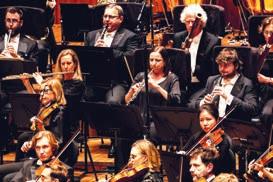
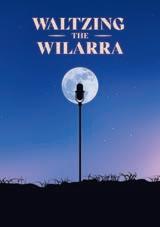
SYDNEY SYMPHONY ORCHESTRA: DVOŘÁK & STRAUSS
AT THE ART HOUSE, WYONG – Friday 8 August
A one-night-only performance of breathtaking woodwind works from Dvořák and Strauss. Expect rich tones, rustic folk motifs and playful passages from one of Australia’s most acclaimed orchestras. thearthousewyong.com.au
FASHION THRIFT SOCIETY AT BREAKERS INDOOR
SPORTS STADIUM, TERRIGAL – Saturday 16 August
Australia’s biggest curated pre-loved clothing market is rolling into Breakers Stadium with over 200 stalls offering vintage fashion, designer finds, handmade goods and homewares. Plus: DJs, nail bars, food trucks, henna tattoos and freebies galore.
fashionthriftsociety.com.au
WALTZING THE WILARRA AT LAYCOCK STREET
COMMUNITY THEATRE – Saturday 23 August
This original musical play is a rich blend of vaudeville, politics and 1940s nostalgia. Set in a post-war dance hall, it’s a powerful story of love, race and reconciliation through time.
laycockstreettheatre.com
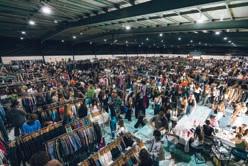
GOSFORD ART PRIZE AT GOSFORD REGIONAL GALLERY
– Saturday 6 September to Sunday 9 November
Back and bigger than ever, the Gosford Art Prize boasts its largest prize pool to date with $25,000 up for grabs for the major winner and $10,000 prizes across ceramics, moving image and First Nations art. gosfordregionalgallery.com
GOD OF CARNAGE AT LAYCOCK STREET THEATRE – Saturday 13 September
A civilised discussion quickly unravels in this biting, fast-paced comedy. When two couples meet to discuss a playground incident between their sons, polite conversation soon gives way to chaos, name-calling and flying insults. Echo Theatre’s vibrant new production peels back the façade of middle-class politeness to reveal the primal instincts lurking beneath.
laycockstreettheatre.com
TWIST FESTIVAL – Tuesday 30 September to Sunday 5 October
A vibrant, inclusive festival celebrating LGBTIQ+ arts and culture across the Coast with events in Gosford, Woy Woy, Ettalong and Umina. From theatre and cabaret to youth events, parties, bingo and more, this is one unforgettable celebration of diversity.
coastaltwist.org.au
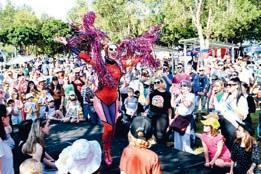
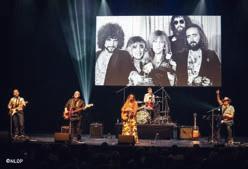

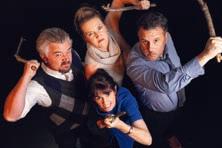

ROMEO & JULIET BELL SHAKESPEARE AT THE ART HOUSE, WYONG – Thursday 2 October
Fall in love all over again with this critically acclaimed take on Shakespeare’s greatest love story. With dazzling performances by Madeline Li and Ryan Hodson, Bell Shakespeare brings passion and heartbreak to the centre stage.
thearthousewyong.com.au
– Saturday 11 October
Enjoy an afternoon of iconic 70s hits under the gumtrees at the stunning Pearl Beach Arboretum. Sing along to favourites from Jackson Browne, Fleetwood Mac, The Eagles, Carly Simon, James Taylor and more. Pack a picnic, bring your rug or chair, and don’t forget your dancing shoes.
pearlbeacharboretum.org.au/events
DAVISTOWN PUTT PUTT REGATTA & WOODEN BOAT FESTIVAL – Sunday 19 October
Celebrate the craft and culture wooden boats at this long-running regatta with heritage vessels, dragon boats, markets and family fun. Now in its 27th year, this is one of the Coast’s biggest community events.
davistownputtputt.com
– Friday 24 to Sunday 26 October
Chrome, cars and rock’n’roll! With more than 450 pre-1979 show cars, live music across five stages, retro stalls, dancing and fashion parades, ChromeFest is a beloved highlight of the spring calendar. chromefest.org
– Friday 7 to Sunday 16 November
A 10-day celebration of the Coast’s beautiful lakes and waterways with family-friendly fun, live entertainment, water sports, environmental programs and more. The perfect way to reconnect with nature and community.
facebook.com/thelakesfestival
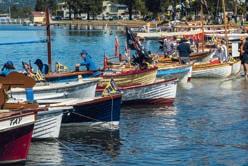
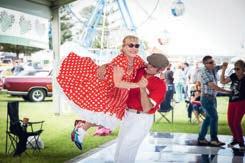
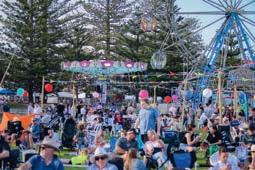
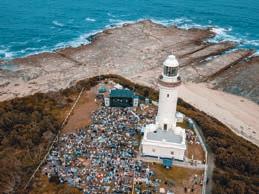
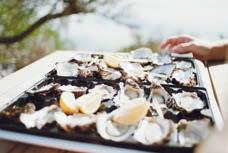
– Sunday 9 November
Taste your way through the finest local produce at this foodie favourite with oysters, wine, craft beer and a buzzing market atmosphere by the water.
deepwaterplaza.com.au/whats-on/oysterfestival
Saturday 15 November
Music, food and wine combine in a stunning location, Norah Head Lighthouse, for this annual knees-up. With a line-up of amazing artists, run don’t wait too long to buy your tickets – it’s a sell-out every year! lighthousefest.com.au
Spring offers the perfect chance to reconnect with nature but also brings a seasonal spike in pet emergencies. Dr Natashia Evans at Animal Referral Hospital (ARH) Gosford shares some advice on what pet parents should watch out for.
Snakes and ticks are waking up
Spring weather means the return of paralysis ticks and snakes. Paralysis ticks are found all over the region, so whether you live here or are visiting, ensure your pet is up to date with their parasite prevention. And perform daily checks by running your hand through your pet’s fur.
Eastern brown snakes and red-bellied blacks become more active as temperatures rise. If your dog or cat is bitten, head immediately to your nearest vet – every minute counts.
Heatstroke happens fast
Dogs, especially flat-faced breeds like pugs and Frenchies, can overheat quickly, even on pleasant 22–25°C days. Avoid walks in the middle of the day, bring water and rest often in shaded areas.
On hot days, a good way to judge if it’s too hot, is by putting your
hand on the footpath. If it’s too hot for your hand, it’s too hot for your dog’s paws.
Bushwalks and beaches: know the rules
Always check leash laws and trail restrictions as well as potential foxbaiting areas. No National Parks are open to pets: on- or off-leash. Many of our beaches have off-leash areas but make sure you check the signage first. Keep an eye on tide conditions and avoid rock pools, sea urchins and sharp shells.
Pack a pet adventure kit
Before heading out, stock a small kit: water, collapsible bowl, tick remover, snake bandage and a basic first aid kit.
Keep your vet’s number saved in your phone and know where the nearest emergency clinic is, such as the Animal Referral Hospital in West Gosford.
Spring is a great time to get active with your furry friend but a little preparation goes a long way in preventing panic and pain. Nature is beautiful, but she doesn't always come with warning signs.

WORDS KAY FISHER
When I think about sports activities with my neurodivergent children, images of Saturday mornings unfold, a whirlwind of lost uniforms in the laundry pile, hot coffee warming my hands on chilly winter mornings and the excitement of visiting the playing field with the best sausage sandwiches. There are the small rituals like lining up bags, bats and boots the night before, gathering friends for carpooling and cheering wildly with parents from the sidelines.
But sport isn’t always this colourful for every family. If your child is neurodivergent, these experiences can look entirely different. Perhaps your child has challenges navigating the nuances of
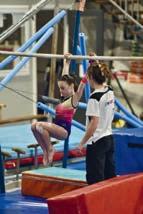
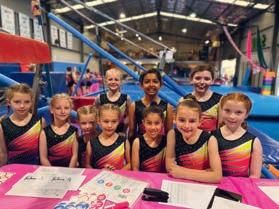
friendships, body language or social cues, or sticking strictly to instructions from a coach or instructor. Maybe they have a narrow range of interests, which makes connecting with peers harder, or there are sensory sensitivities that amplify or dull their perception of touch, sound or vision. These complexities can make the world of sports and activities feel intimidating for families.
We’ve put together a collection of activities thoughtfully designed for neurodivergent families who may face these kinds of hurdles. We want to share activities that can be a source of delight not stress, and include spaces where every child, regardless of their unique needs can thrive and feel supported.
Kimnastix in Tuggerah welcomes families seeking inclusive opportunities for their neurodivergent children. This gymnasium stands out as a beacon of belonging, thoughtfully designed to meet the needs of every child regardless of their abilities, learning styles or confidence levels.
The instructors understand that every child’s journey is distinctive, taking things slowly and meeting them right where they are, with compassion and patience.
The classes are built around activities that promote strength, flexibility, coordination and balance, tailored to match your child’s individual skill level. Children are offered a structured yet playful environment that fosters both physical and sensory development. They begin with fundamental movements, such as rolls, handstands and cartwheels helping to build core strength, coordination and balance. Engaging in these activities is especially beneficial for their vestibular (inner ear) system, which plays a key role in regulating balance and spatial awareness.
Many neurodivergent children experience sensory processing challenges, and gymnastics provides a controlled yet dynamic way to stimulate and strengthen. From the group warm-up to apparatusbased exercises and warm-down stretches, each part of the class supports body awareness and emotional regulation. Most importantly, these classes emphasise enjoyment and social engagement, ensuring that children feel encouraged and supported while developing essential motor and sensory skills. kimnastix.com.au
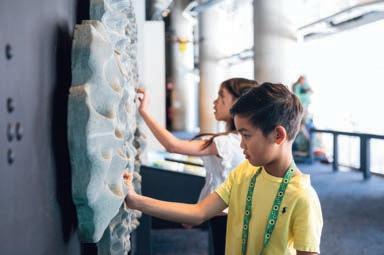

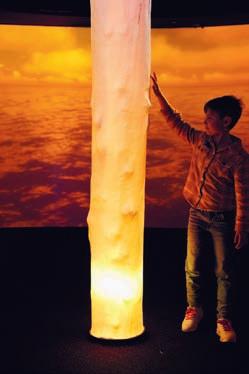
Imagine a place where children with additional needs can explore and thrive in an environment tailored just for them, a space where they can regulate their emotions and sensory experiences without stress or judgment. On the Central Coast, we’re fortunate to have exactly that thanks to Rocking the Senses, a groundbreaking initiative designed to bring inclusivity and joy to neurodivergent children.
Founded by Hailey and her husband, devoted parents of a young son with autism, Rocking the Senses is Australia’s first mobile sensory van that brings sensory friendly experiences directly to families, schools and communities.
The mobile sensory van is a vibrant and welcoming oasis equipped with tools and activities that cater to sensory, vestibular and cognitive needs. Whether it’s engaging with calming lights, gentle music, sensory swings or tactile exploration, every feature is designed to help children regulate their bodies and emotions in a playful, fun and stress-free way.
Hailey has designed the space as a refuge where children can feel included, especially those who may face difficulties such as bullying or emotional dysregulation. For parents juggling therapy schedules, travel and everyday stresses, it offers a practical and compassionate solution right in their community or even their own front yard.
Rocking the Senses offers various programs, including:
• Weekly sensory playgroups held every Tuesday from 10.30 am to 12.30 pm at the Central Coast Lifetime Learning Centre in Palmdale.
• Sensory incursions at preschools and primary schools.
• Custom sensory room designs and installations for schools and organisations.
• Collaborations with the Central Coast Council to provide sensoryfriendly experiences at regional festivals and events.
• As a heartwarming bonus, the initiative also includes a therapy assistant pup.
Equine therapy offers a unique and deeply meaningful way for neurodivergent children to connect and grow. If your family has ever navigated the long list of therapeutic interventions – speech therapy, occupational therapy, physiotherapy – you know how these can sometimes feel like one more stressful thing to fit into an already busy schedule. While many of these sessions can be enjoyable for children struggling with impulsivity, self-control, anxiety or emotional recognition, equine therapy provides something profoundly different; a sense of calm connection wrapped in the gentle presence of horses.
Owned by Natasha, a compassionate counsellor and lifelong animal lover, Seen and Herd’s equine therapy program is a safe haven for children to explore their emotions and learn to manage challenging behaviours. With a person-centred somatic approach, Natasha crafts activities that help kids feel grounded and empowered all without feeling like they’re ‘in therapy’. Instead, they are immersed in fun hands-on learning alongside these majestic animals.
It’s all about fostering connection with the children learning to interact with horses safely, grooming them, haltering and leading them, and discovering their fascinating nature. There’s no riding involved, making it accessible and comfortable for children of all ability levels.
Ideal for children aged seven to 12, sessions are intentionally small with no more than six children per group. Lasting 2.5 hours, these sessions offer not just therapy but an opportunity for children to discover themselves and their confidence in building relationships
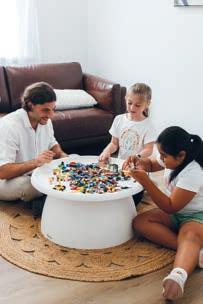
seenandherd.com.au
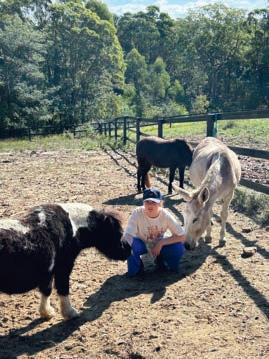
NeuroKind serves as a dedicated centre for neurodiverse individuals, offering families not only traditional ASD/ADHD assessments and psychology but also specialised programs tailored to varied interests of your children.

The skilled team has carefully developed programs where your child or teen and their adult carer can feel in control of the experience while developing skills and tapping into their specific passions. NeuroKind offers tailored parenting and family support programs, equipping caregivers with strategies and resources to nurture positive relationships and effective communication. Their therapeutic and social group programs provide a welcoming environment for clients to connect, share experiences and build confidence through structured activities and peer interactions.
With workshops, holiday programs and term support initiatives like Neuro Art, Neuro Build, Neuro Blox, Neuro Drama, Neuro Sense, Neuro Cook and Neuro Game, there really is something for everyone. Weekly sessions are offered throughout the term. Each interest-led program will have a different individual outcome for each child and tailored to their specific needs, without the pressure to conform.
neurokind.au
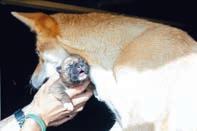
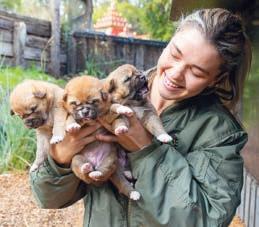
First time mum, Chilli, gave birth to three bouncing baby dingoes early one (chilly) morning at the Australian Reptile Park with dad, Bandit, being caring and helpful, licking the first puppy’s head as it was being born.
Chilli took to motherhood like a veteran, bonding quickly with her pups.
‘It was such a beautiful moment,’ says keeper Seleena de Gelder. ‘Chilli is the sweetest mum and watching her with them has been one of the most rewarding experiences of my career.’
In the wild, dingoes are known for their strong family bonds and dad will even bring food for the pups after they are weaned.
The pups – Socks, Muffin and Rusty – are thriving, and are now old enough for visitors to see them exploring their enclosure. You can even enjoy the chance to cuddle them at the daily, Dingo Puppy Encounters. The pups are already fulfilling their ambassador role too, helping to raise awareness for the part their wild cousins play in maintaining a balance within nature and helping to keep feral cat and fox numbers down.


‘The horses don’t judge a child by their disability. They just listen and respond.’
WORDS SUZY JARRATT PHOTOS STEVE SPINKS
Black Beauty, Flicka, Mr Ed and Trigger – they are legendary celebrity horses known throughout the world. And then there are the horses of the RDA whose work surely surpasses that of any equine celebrity. They provide a unique contribution of joy, inspiration and confidence to those with a disability.
COAST magazine recently visited the Somersby branch of Riding for the Disabled where the association was holding sessions with some of the special education pupils from Killarney Vale School.
This RDA centre in Kangoo Road has excellent amenities including a large indoor arena and spotless stables and shelters, spacious paddocks, a well-appointed tack room, office and kitchen.
Former show hacks, jumpers, kids’ reject ponies and stock horses – they come from everywhere, all in different sizes and colours. To be accepted they need tolerance of all things strange and spooky and to behave impeccably when being ridden.
‘Before becoming permanent residents the horses must successfully undergo a six-week trial. We have ten horses here presently,’ explained coach Merelynne Southall, ‘with one recently retired. All are geldings and range from 15 years upwards.’
Keeping an eye on them is local vet Dr Katerina Skarbek from Somersby Animal Hospital. ‘This veterinary practice provides a wonderful service to our centre,’ said Merelynne.
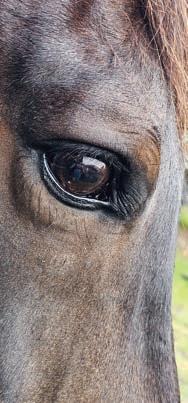
‘I
had the privilege of leading a young girl with vision impairment. She was slumped in her seat. And then I mentioned how lucky she was that she was so good at feeling the horse’s every muscle movement – more than people distracted by vision. I could see the difference in her as she sat up straighter and more confident! That was my biggest reward.’
Catharine Retter, ed.
she said. ‘The physical aspects of these horseback sessions are so beneficial helping with the children’s dexterity, balance and even learning left from right.’
There is always someone handling the lead rope and often two sidewalkers, especially when riders are wearing ‘pelican belts’. These are fitted with handles which can be held to provide stability and support.
‘The people here are so patient, they’re amazing,’ added Christy.
At Somersby there are 60 volunteers, more are always welcome.
Much of the saddlery is donated and, if it cannot be used at Somersby, it is sold and the money put towards horse maintenance. Keeping just one horse costs about $2,500 each year.
Christy Smith, assistant principal of Special Education at Killarney Vale School, praises the work done by all at the RDA.
‘During each term we visit for about an hour every week. The children, some of whom are non-verbal, have all types of disabilities,’
Steve Spinks, from Wyong, is one of them. He helps upkeep the stables, does the painting and fixes all the things which go wrong on equestrian properties. He leads the riders as well.
‘But we volunteers get more than we give,’ he declares. ‘It’s the horses – they are the real heroes.’ C
RDA Centre, Kangoo Road, Somersby rdacentralcoast@gmail.com
